Characteristics of States' Alternate
Assessments Based on Modified Academic
Achievement Standards in 2010-2011
Synthesis Report 85
Lynn M. Price • Jennifer
R. Hodgson • Sheryl S. Lazarus • Martha
L. Thurlow
September 2011
All rights reserved.
Any or all portions of this document may
be reproduced and distributed without
prior permission, provided the source is
cited as:
Price, L. M., Hodgson,
J. R., Lazarus, S. S., & Thurlow, M. L.
(2011). Characteristics of states'
alternate assessments based on modified
academic achievement standards in
2010-2011 (Synthesis Report 85).
Minneapolis, MN: University of
Minnesota, National Center on
Educational Outcomes.
Table of Contents
Executive Summary
All students, including students with disabilities, participate in state
accountability systems. Most students with disabilities participate in the
regular assessment, with or without accommodations. Students with more
significant cognitive disabilities participate in the alternate assessment based
on alternate achievement standards (AA-AAS). A few states also have an alternate
assessment based on grade-level achievement standards (AA-GLAS) for students
with disabilities who need testing formats or procedures that are not included
in the regular assessment and are not addressed with the use of accommodations.
In 2007, federal regulations introduced another assessment option—the alternate
assessment based on modified academic achievement standards (AA-MAS). Eligible
students may be from any disability category, and they must be considered
unlikely to achieve grade-level proficiency within the time period covered by
their Individualized Education Program (IEP) and must have IEP goals based on
grade-level content standards. The AA-MAS is an optional assessment.
The National Center on Educational Outcomes (NCEO) has been tracking the
characteristics of states' AA-MAS since 2007. According to the 2009 NCEO update
on test characteristics, 13 states had developed what they considered to be an
AA-MAS, and three states (Texas, Kansas, and Louisiana) had received federal
approval. The current report found 17 states that by the 2010-11 academic school
year had developed, or were developing, what they considered to be an AA-MAS,
and one additional state (North Carolina) had received federal approval.
All states' AA-MAS contained multiple-choice items with fewer states using
constructed response items and performance task items. The current report also
tracked test design changes between the AA-MAS and regular assessment. At least
half of the states incorporated the following test design changes:
additional graphics, additional white space, distractor removed, fewer items,
fewer items/page, key text underlined/bolded/bulleted, larger font size, one
column format, segmenting of passages, shorter passages, simplified graphics,
and simplified language.
This study also tracked whether states' AA-MAS were computer-based, whether
states with computer-based tests (CBTs) included tutorial and practice test
opportunities, and whether states' documents included considerations for English
Language Learners (ELLs) with disabilities. Six of the seventeen states had a
computer-based test—four also provided tutorials and five provided practice
tests. Documents from nine states suggested that the needs of ELL students
participating in the AA-MAS were considered.
Top of page |
Table of Contents
Overview
Federal legislation requires that all
students participate in state
accountability systems. For students
with disabilities, a variety of options
is available for participation in state
assessments. Most students with
disabilities participate in the regular
assessment, with or without
accommodations. Students with more
significant cognitive disabilities may
participate in the alternate assessment
based on alternate achievement standards
(AA-AAS). A few states also have an
alternate assessment based on
grade-level achievement standards
(AA-GLAS) for students with disabilities
who need testing formats or procedures
that are not included in the regular
assessment and are not addressed with
the use of accommodations.
In 2007, federal regulations offered
another assessment option for students
with disabilities that provided states
with the flexibility to develop an
alternate assessment based on modified
academic achievement standards (AA-MAS).
Students who participate in an AA-MAS
may be from any disability category, and
their IEP goals must align with
grade-level content standards. The
regulations also require that students
must have access to grade-level content
but be unlikely to achieve grade-level
proficiency within the time period
covered by their IEP. For accountability
purposes, states may count up to two
percent of all students as proficient
who met proficiency standards with an
AA-MAS (U.S. Department of Education,
2007). States are not required to offer
this assessment option.
The National Center on Educational
Outcomes (NCEO) has annually tracked and
analyzed the characteristics of states'
AA-MAS since 2007 (Hodgson, Lazarus, & Thurlow, 2010; Albus, Lazarus, Thurlow,
& Cormier, 2009; Lazarus, Thurlow,
Christensen, & Cormier, 2007). This
report updates Hodgson et al. A
companion report on states'
participation guidelines for the AA-MAS
in 2010 (Lazarus, Hodgson, Price, & Thurlow, 2011) is available at the NCEO
Web site.
Need to Update and Analyze
During the 2009-2010 school year,
NCEO compiled and analyzed information
about the test characteristics of
states' AA-MAS and found that 13 states
had either implemented or were
developing a test that the states
considered to be an AA-MAS. Three states
in the 2009 report (Kansas, Louisiana,
and Texas) had successfully completed
the U.S. Department of Education's peer
review process for their AA-MAS (Hodgson
et al., 2010). As of June 2011, 17
states had either implemented or were
developing an AA-MAS, and one additional
state (North Carolina) had received
federal approval after successfully
completing the federal peer review
process.
As a fairly new assessment option,
the characteristics of states' AA-MAS
continue to change frequently. With
states continuing to revise their tests
and a few more states developing an
AA-MAS option, identifying and analyzing
these changes is important to help
states make informed decisions. Similar
to the previous report (Hodgson et al.,
2010), the current report continued to
track characteristics of states' AA-MAS
as well as key differences across states
regarding considerations for
computer-based tests (CBTs) and English
Language Leaners (ELLs) with
disabilities. We wanted to learn whether
the characteristics of this assessment
were continuing to change. The specific
research questions we sought to answer
were:
- During the 2010-2011 school
year, which states had an assessment
they considered to be an AA-MAS?
- What were the characteristics of
these assessments and how had they
changed since the 2009-2010 school
year?
- Which states had computer-based
tests for their AA-MAS and how had
they changed since the 2009-2010
school year?
- WWhich states had publicly posted
considerations for ELL students with
disabilities participating in the
AA-MAS, and how had they changed
since the 2009-2010 school year?
Process Used to Find Information
about States' AA-MAS
In January 2011, state department of
education Web sites were searched to
identify states that had an AA-MAS or an
AA-MAS in development. Seventeen states
were identified. State documents related
to AA-MAS characteristics were
downloaded for each state. State
documents downloaded included fact
sheets, brochures, guides, test
administration manuals, newsletters,
test or item specifications, and
PowerPoint presentations. Item samplers
or practice tests were also downloaded
to compare items from states' AA-MAS
with items from the regular assessments.
The documents used in this analysis are
listed in Appendix A.
The current report is an annual
update. We surveyed AA-MAS test
characteristics for 2010-2011. In the
2009-2010 NCEO update on AA-MAS test
characteristics (Hodgson et al., 2010),
researchers collected information during
February 2010. Similarly, in the current
annual update of the report, we
collected information from January 2011
to March 2011, and refer to the
2010-2011 school year throughout the
report.
All named test design changes in the
previous report were tracked and
included in this report if any states
made the change this year. Test design
changes are included by name in this
report when they are mentioned in the
materials of at least three states or if
they were tracked in the previous
report. If the change was not common to
at least three states or tracked in the
previous report, it was included in the
other category. If a new design
change is tracked in the current report
by name, information in the previous
report pertaining to these changes was
included. Many of these changes were
listed in the previous NCEO report in
the other category. Detailed
descriptions about these "other" changes
were found in the appendix tables of
Hodgson et al. (2010) of the previous
report.
This year we also expanded the
description of one design change tracked
in previous reports (key text
underlined/bolded) to include
changes related to bulleting text (key
text underlined/bolded/bulleted).
This change was made because it better
reflects the way this change is included
in many state documents.
Hodgson et al. (2010) tracked and
provided descriptions related to online
or computer-based testing for states'
AA-MAS in 2009-2010. This year we also
tracked the availability of online
tutorials and practice tests.
In April 2011, state profiles were
prepared and sent to state directors of
assessment via e-mail. Each profile
contained the specific AA-MAS
information that was collected for a
state. States were asked to verify the
information within two weeks. States
were permitted to revise their profiles
if inaccurate information was found,
provided we could confirm their changes
with posted state information. States
that had not responded within two weeks
were sent a follow-up e-mail. Fourteen
out of the seventeen states responded.
States confirmed the accuracy of the
information, suggested one document over
another, or filled in other information.
If a state did not respond to the
requests, we assumed the data were
correct and considered it verified. The
verified information is summarized in
this report.
Top of page |
Table of Contents
Results
Thirteen states (California,
Connecticut, Indiana, Kansas, Louisiana,
Maryland, Michigan, North Carolina,
North Dakota, Ohio, Oklahoma, Tennessee,
and Texas) were identified as having
publicly available information on test
characteristics for an AA-MAS in the
previous report for the 2009-2010 school
year—though there was little publicly
available information for the assessment
that Indiana was developing. Therefore
the analysis results presented in the
2009-2010 report included data from only
12 states (Hodgson et al., 2010). Four
additional states (Georgia, Minnesota,
Pennsylvania, and Virginia) were
identified for the current report. Table
1 provides the state, the name of the
state's AA-MAS, and the content areas
and grades for this assessment option.
Table 1. AA-MAS Name, Content
Area, and Grade Described by State as of
March 2011
|
State
|
Assessment
Name
|
Content
Areas/Grades
|
|
California
|
California
Modified Assessment (CMA)
|
Math (3-7);
English Language Arts (3-11);
Writing (4, 7); Science (5, 8);
Algebra I (7-111);
Geometry (8-111);
Life Science (10)
|
|
Connecticut
|
Connecticut
Mastery Test Modified Assessment
System (CMT MAS) and Connecticut
Academic Performance Test
Modified Assessment System (CAPT
MAS)
|
Math and Reading
(3-8, 102)
|
|
Georgia
|
Georgia
Criterion-Referenced Competency
Tests—Modified (CRCT-M)
|
Math and Reading
(3-8); English Language Arts
(3-8)
|
|
Indiana
|
Indiana Modified
Achievement Standards Test
(IMAST)
|
Math and English
Language Arts (3-8); Science (4,
6); Social Studies (5, 7)
|
|
Kansas3
|
Kansas
Assessment of Modified Measures
(KAMM)
|
Math and Reading
(3-8, HS); Writing (5, 8, HS);
Science (4, 7)
History-Government (9, 11)
|
|
Louisiana
|
Louisiana
Educational Assessment Program
(LEAP) Alternate Assessment,
Level 2
|
Math and English
Language Arts (4-8, 10-11);
Science (4, 8, 11); Social
Studies (4, 8, 11)
|
|
Maryland
|
Maryland
Modified High School Assessment
(Mod-HSA); Maryland Modified
School Assessment (Mod-MSA)
|
Math and Reading
(3-8); Algebra, Biology,
English, and Government (HS)
|
|
Michigan
|
Michigan
Educational Assessment Program
(MEAP) Access
|
Math and Reading
(3-8); Writing (4, 7)
|
|
Minnesota
|
Minnesota
Comprehensive Assessment (MCA)
Modified
|
Math and Reading
(5-8, 10)
|
|
North Carolina
|
NCEXTEND2
Alternate Assessment for
End-of-Grade (EOG)
|
Math and Reading
(3-8); Science (5, 8)
|
|
North Dakota
|
North Dakota
Alternate Assessment 2 (NDAA2)
|
Math and
Reading/Language Arts (3-8, 11);
Science (4, 8, 11)
|
|
Ohio
|
Ohio's Alternate
Assessment based on Modified
Achievement Standards (AA-MAS)
|
Math and Reading
(5-8, 10)
|
|
Oklahoma
|
Oklahoma
Modified Alternate Assessment
Program (OMAAP)
|
Math and Reading
(3-8); Science (5, 8);
End-of-Instruction Tests, High
School (Algebra I, Biology I,
English II, and U.S. History)
|
|
Pennsylvania
|
Pennsylvania
System of School
Assessment-Modified (PSSA-M)
|
Math and Reading
(4-8, 11); Science (8, 11)
|
|
Tennessee
|
Tennessee
Comprehensive Assessment Program
(TCAP) Modified Academic
Achievement Standards (MAAS)
|
Math and
Reading/Language Arts (3-8);
Science (3-8); Social Studies
(3-8)
|
|
Texas
|
Texas Assessment
of Knowledge and Skills Modified
(TAKS-M)
|
Math (3-11);
Reading (3-9); English Language
Arts (10-11); Writing (4, 7)
Science (5, 8, 10-11); Social
Studies (8, 10, 11)
|
|
Virginia
|
Virginia
Modified Achievement Standards
Test (VMAST)
|
Math and Reading
(3-8); Algebra 1 (End-of-Course)
|
1Students will complete the assessment
during one of the school years
mentioned.
2CAPT MAS is available as a live test
for identified grade 10 students and as
a retest for individual students in
grade 11 and 12.
3Kansas offers KAMM Opportunity to Learn
(OTL) assessments for grades 9-12 in
math, reading, science, writing, and
history-government. The OTL assessments
are designed to give students the
opportunity to learn the content
standards prior to participation in the
KAMM. According to the Kansas Assessment
Examiner's Manual this assessment option
"provides High Schools with flexibility
in determining when to assess students."
All states in the current report
assessed students in reading and
mathematics. Some states also offered
AA-MAS tests for science, social
studies, or other content areas. The
majority of states offered the AA-MAS in
grades 3-8. Some states offered the test
at the high school level or at fewer
grade levels. Most states had
operational assessments across all
content areas. Figure 1 shows 14 states
had operational assessments across all
content areas, no states had operational
assessments in some content areas and
developing in others, and three states
were still developing their assessment
across all content areas. See Table B1
in Appendix B for details.
Figure 1. Number of States with an
Operational AA-MAS as of January 2011

Different types of questions were
included on states' AA-MAS. Figure 2
presents the number of states across
2009-2010 (n=12) and 2010-2011 (n=17)
with information on AA-MAS question
characteristics. Multiple choice,
constructed response, performance tasks,
and writing prompts were identified as
different types of questions used by
states. States were not counted more
than once in any category. For example,
if a state used multiple choice
questions and performance tasks in one
content area, the state would be counted
in both categories. However, a state
with performance tasks in both reading
and mathematics would be counted once in
that category. See Table B2 in Appendix
B for more details.
The assessments of all states with an
AA-MAS included multiple choice items in
both 2010-11 and 2009-2010. Overall, the
percentage of states using constructed
response items, writing prompts, and
performance tasks on the AA-MAS
decreased. Three of the seventeen states
(18%) in 2010-2011 used constructed
response items compared to four out of
twelve states (33%) in 2009-2010. The
number of states using writing prompts
in 2010-2011 was five of seventeen
states (29%) in comparison to five out
of twelve states (42%) in 2009-2010.
Only one state used performance tasks in
both years.
Figure 2. Number of States by Question
Characteristic across Study Years

&
Assessment Design Changes
Figure 3 compares states' AA-MAS test
design changes from 2009-2010 to
2010-2011. The previous NCEO report
tracked 16 design changes by name. As
described in the Process section, this
report tracks by name any design changes
mentioned by three or more states, as
well as all design changes included in
the previous report. Using this
criterion, six additional design changes
were tracked by name in this report (em>add
hint/thought boxes, additional white
space, eliminate grid-in items, embedded
formulas/conversions, limit steps in
multi-step problems, and simplified
numbers).
States' design changes for the AA-MAS
varied across study years and across
states (see Figure 3). In the current
study, states were most likely to use
simplified language (n = 16). Distractor
removed, fewer items, key text
underlined/bolded/bulleted, and shorter
passages were also popular test design
changes (n = 14). The largest increase
was observed for states using simplified
language, increasing to 16 out of 17
states (94%) in 2010-2011 from 7 out of
12 states (58%) states in 2009-2010.
Another large increase was additional
white space, which increased to 10 out
of 17 states (59%) in 2010-2011 from 3
out of 12 states (25%) in 2009-2010.
Simplified numbers and limit steps in
multi-step problems also increased
considerably. Both of the design changes
increased to eight out of seventeen
states (47%) in this report from two out
of twelve states (17%) in the previous
one. Small decreases from 2009-2010 to
2010-2011 were found in percentages of
states using different typeface and
calculator design changes.
States sometimes provided detailed
descriptions about certain test design
changes. AA-MAS test design change
specifications are discussed in more
detail here for each design change.
Additional information and the detailed
specifications are presented in Tables
B3 and B4 in Appendix B.
Figure 3. States' Assessment Design
Changes for the AA-MAS across Study
Years

Add Hint/Thought Boxes. Documents from
five states (Georgia, Michigan,
Pennsylvania, Tennessee, and Virginia)
indicated that hint or thought boxes
were used on the AA-MAS. States
generally indicated that a hint or
thought box was used to provide helpful
reminders to ensure understanding of a
question. For example, Pennsylvania
added "helpful hints or thought boxes to
provide further definition of words and
terminology and/or support the text or
emphasize main ideas." Georgia indicated
that "these hints are designed to serve
as helpful reminders, providing
information to aid students in
understanding what the question is
asking."
Additional Graphics. Eleven states
(California, Indiana, Kansas, Michigan,
Minnesota, Ohio, Oklahoma, Pennsylvania,
Tennessee, Texas, and Virginia) included
additional graphics on their AA-MAS.
Many of the states indicated graphics
were added but did not provide
additional detail. A few states provided
information about when or why additional
graphics were added. For example, both
Oklahoma and Texas shared, "provide
additional graphics to support text,
emphasize ideas, and facilitate
comprehension."
Additional White Space. Ten states
(California, Connecticut, Georgia,
Indiana, Maryland, Michigan, Minnesota,
Pennsylvania, Tennessee, and Texas) had
an AA-MAS that used additional white
space. Some states provided specific
descriptions of when white space was
added. Tennessee indicated additional
white space was added "between
paragraphs of passages" and "between
numbers of sequences or graphics."
Georgia shared that "the line spacing
between items was increased." Some
states specifically stated they included
additional white space in relation to
fewer items per page. For example, Texas
stated, "more white space due to fewer
items per page."
Breaks as Needed. Three states
(Michigan, North Dakota, and Ohio)
included breaks as needed as a design
change on their AA-MAS. Michigan and
North Dakota provided general
information that indicated that students
may take breaks as needed. For example,
North Dakota stated, "Students should be
provided with comfortable workstations,
a relaxed testing schedule, frequent
breaks, and the presence of a competent
test administrator," whereas Ohio
provided detailed directions for test
administrators to follow when providing
a break to all students at once and
restroom breaks for individual
students—and indicated that breaks were
allowed "if district policy allows":
Breaks are strongly encouraged during
each testing session, if district policy
allows breaks. TAs should tell students
before the assessment what they may do
during the breaks. TAs should follow the
directions below when providing a break:
Before the test begins, let students
know when the break will occur. Have a
watch or a clock available to time the
length of the break. Students will
remain in the assessment room. No
talking will be allowed during the
break. Students should be encouraged to
stand for a stretch break at their
desks. No additional materials should be
taken out during a break. Only the
student test booklet (closed and face
down) and pencil should be on the desk.
When the entire group has had a break,
students will resume the assessment.
Calculator. Two states (Indiana and
Louisiana) integrated calculators into
AA-MAS test design. Both states
permitted the use of a calculator on all
sessions of the mathematics content area
of the AA-MAS; students taking the
general assessment used a calculator
only on some sessions of the mathematics
test. Louisiana stated, "Calculator use
is permitted on all sessions," and "It
is recommended that a calculator be made
available to each student for
instructional and assessment purposes."
Different Typeface. Six states
(California, Connecticut, Oklahoma,
Pennsylvania, Tennessee, and Texas)
indicated the use of a different
typeface as a design change on the
AA-MAS test. Four of the states provided
information about what typeface was used
for the AA-MAS. Connecticut, Oklahoma,
and Texas indicated they used Verdana
font and California used Helvetica font.
Distractor Removed. Fourteen states
(California, Connecticut, Indiana,
Kansas, Maryland, Michigan, Minnesota,
North Carolina, North Dakota, Ohio,
Oklahoma, Tennessee, Texas, and
Virginia) removed distractors as a test
design change on the AA-MAS. Some states
described removing distractors in
general terms and a few states provided
more specific descriptions of how
distractors were removed. For example,
North Carolina and Ohio broadly stated
that three answer choices were used and
Oklahoma stated, "provide only three
answer options instead of four," and
specifically mentioned that the English
II assessment was designed to "eliminate
answer choices that give students the
option of making no changes to the
item."
Eliminate Grid-in Items. Four states
(Connecticut, Indiana, Minnesota, and
Texas) eliminated grid-in items from the
mathematics content area as a test
design change on the AA-MAS. Generally,
grid-in items referred to items that
students completed by filling in their
produced answer into a response grid
rather than selecting an answer from
choices. To complete grid-in items,
students had an area to write their
response followed by needing to fill in
the appropriate circles under each
number they wrote in the top row. States
referred to these as grid-in items,
gridded-response items, or griddable
items. Moreover, the four states
indicated that this type of item was
deleted from their AA-MAS, none were
included on the AA-MAS, or the items
were converted into multiple choice
questions. For example, Connecticut
stated, "all grid-in items converted to
multiple choice items," while Texas
indicated, "delete griddable items."
Embedded Formulas/Conversions. Nine
states (Connecticut, Georgia, Indiana,
Michigan, Minnesota, Oklahoma,
Pennsylvania, Texas, and Virginia)
included appropriate embedded formulas
and conversions as a test design change
on the AA-MAS. Embedded formulas and
conversions were typically used for math
and science tests. The specifications
differed across states. Most states
indicated where embedded formulas or
conversions should be added. For
example, Connecticut said "formulas and
conversions embedded in test items," and
Texas indicated, "provide appropriate
formula or conversion near the item" for
its math and science tests. Pennsylvania
included a reason why the state embedded
formulas and conversions for the math
AA-MAS: "A formula hint and a conversion
hint have been added below the stem to
guide the students."
Fewer Items. Fourteen states
(California, Georgia, Indiana, Kansas,
Louisiana, Maryland, Michigan,
Minnesota, North Carolina, North Dakota,
Oklahoma, Pennsylvania, Tennessee, and
Texas) had fewer items as a design
change for the AA-MAS. Some of the
states specified what type of items were
deleted (e.g., gridded-response items or
constructed-response items). Both Texas
and Oklahoma stated that negative items
and "items that cannot be modified based
on guidelines" should be deleted.
Minnesota discussed the proportion of
items in each content area: "The number
of operational items within a form are
reduced from that used by MCA-III while
maintaining the proportion of content
coverage across strands and standards."
Fewer Items/Page. Twelve states
(California, Connecticut, Georgia,
Louisiana, Maryland, Michigan, North
Carolina, North Dakota, Oklahoma,
Pennsylvania, Tennessee, and Texas) had
fewer items per page. Most of the states
had similar specifications and limited
details for this design change. For
example, North Dakota offered its AA-MAS
as a computer-based assessment and
indicated that "each question is
presented on the full computer screen."
Fewer Passages. Six states (Georgia,
Kansas, Maryland, Oklahoma,
Pennsylvania, and Texas) had fewer
passages for the AA-MAS than for the
regular test. Five of the states
indicated the use of fewer passages but
provided limited details in publicly
available documents. Kansas provided
more information about how the design
change was used for the reading content
area tests:
There are fewer passages to read. At
grades 3 and 4 there are two narrative
and two expository passages. At grades
5, 6, and 7 there are two narrative, two
expository, and one technical passage.
At grades 8 and HS there are two
narratives, two expository, one
technical passage, and one persuasive
passage.
Graphic Organizers. Six states
(Connecticut, Georgia, Ohio,
Pennsylvania, Tennessee, and Virginia)
indicated that graphic organizers were
used on the AA-MAS. The specifications
across states differed from more general
descriptions to very specific
descriptions that included examples of
what graphics organizers entailed. For
example, Ohio indicated, "provide a
graphical structure to help students
organize their thoughts," and Georgia
stated that "graphic organizers (visual
aids that help) accompany some items."
Two states (Tennessee and Pennsylvania)
provided more specific descriptions with
examples. Tennessee stated, "graphic
organizers to aid conceptual
understanding or focus," and "provide a
scaffold: graphic organizers (e.g.,
timeline for organizing chronology) and
table, graph, chart, or visual to
enhance conceptual understanding (e.g.,
Venn diagram to compare and contrast)."
Pennsylvania stated, "provide a
scaffold: Table or map to enhance
comprehension (e.g., timeline for
organizing chronology)."
Key Text Underlined/Bolded/Bulleted.
Fourteen states (Connecticut, Georgia,
Indiana, Kansas, Louisiana, Maryland,
Michigan, Minnesota, Ohio, Oklahoma,
Pennsylvania, Tennessee, Texas, and
Virginia) indicated key text was
underlined, bolded, and bulleted in
their AA-MAS. States had varying levels
of details to describe the design
change, with some states providing
specific descriptions on when or why the
design change was used. Moreover, some
states underlined, bolded, and bulleted
key text while other states used one or
two of the options. For example, Indiana
indicated, "bold for key or essential
words" and "bullet points to organize
and highlight information." Ohio stated
that for the math content area: "Important elements of the problem are
bolded or underlined," and "This will
facilitate structured recall of the
content passage by AA-MAS students."
Larger Font Size. Twelve states
(California, Connecticut, Georgia,
Indiana, Louisiana, Maryland, Michigan,
North Dakota, Oklahoma, Pennsylvania,
Tennessee, and Texas) indicated that a
larger font size was used on their
AA-MAS. Most states provided little
detail about this design change—and
generally just stated that larger font
sizes were used or that the text was
enlarged.
Limit Steps in Multi-step Problems.
Eight states (Georgia, Indiana,
Michigan, Ohio, Oklahoma, Pennsylvania,
Texas, and Virginia) had an AA-MAS that
chose to limit the steps in multi-step
problems. Three states (Indiana,
Oklahoma, and Texas) specified this
design change for science and math
tests. Texas indicated that the change
was used for math and science tests and
stated, "limit the number of steps
and/or operations in multi-step
problems." Similarly, Oklahoma indicated
that the change was used for math,
algebra I, science, and biology I tests
and stated, "limit the number of steps
and/or expectations in multi-step
problems."
Two of the states (Ohio and
Pennsylvania) indicated that this design
change was used as a scaffold for
students and did not specify what
content areas it could be used on. For
example, Ohio indicated, "Use
scaffolding: Break multi-step items into
individual steps, each with questions,"
and "Additional items break up complex
questions into a series of simpler steps
to reduce the planning load."
One Column Format. Nine states
(California, Connecticut, Georgia,
Minnesota, North Carolina, Ohio,
Oklahoma, Pennsylvania, and Texas)
indicated one column format was used on
the AA-MAS. Typically states used one
column format as opposed to a two column
format. For example, Connecticut stated
for its reading test, "elimination of
double-column format for the articles."
A few other states also provided limited
details. Georgia shared "items are
placed in a single-column" and Minnesota
stated "use a single column when
appropriate." Many states did not
provide specific details surrounding the
use of one column formats.
Segmenting of Passages. Nine states
(Georgia, Michigan, Minnesota, Ohio,
Oklahoma, Pennsylvania, Tennessee,
Texas, and Virginia) used segmented
passages on their AA-MAS. Many of the
states specified reading passages were
segmented with the relevant items placed
underneath the smaller segments. For
example, Pennsylvania stated, "separate
reading passages into chunks, followed
by related items." Ohio stated that it
embedded "reading passages within the
passages so that students answer
content-relevant questions immediately
after reading a paragraph about the
content."
Shorter Passages. Fourteen states
(California, Georgia, Indiana, Kansas,
Louisiana, Maryland, Minnesota, North
Carolina, Ohio, Oklahoma, Pennsylvania,
Tennessee, Texas, and Virginia)
shortened passages on the AA-MAS. Some
states mentioned that passages were
shortened on specific tests. Shortening
passages was most commonly used on
reading tests, but was also specified
for mathematics, science, social
studies, or writing in some states. For
example, Indiana specified for English
and language arts, "reduce length of
passage/test," and specified for
mathematics, science, and social
studies, "reducing the length of text."
Some states did not specify a content
area but only stated in general that the
reading amount was reduced. For example,
North Carolina specified, "shorter
reading selections (mostly one page),"
and Virginia said, "Some of the
sentences have been removed from reading
passages."
Three states (Georgia, Kansas, and
Texas) provided detail about what
information may be eliminated from
passages. Texas specified for the
reading test, "Delete extraneous
information that does not affect
development of the selection or any
context related to the tested items."
Kansas also included information related
to working memory in its description for
the reading assessment:
Reduce sentence, paragraph, and passage
length to minimize demands on working
memory. Word count and readability of
KAMM passages are reduced to decrease
the working memory demands on students.
For technical texts, sufficient
information and context is presented to
help students respond to questions, but
the text in general is less complicated
and detailed, and presents little, if
any, extraneous information.
Simplified Graphics. Ten states
(Connecticut, Georgia, Indiana,
Minnesota, Ohio, Oklahoma, Pennsylvania,
Tennessee, Texas, and Virginia) had an
AA-MAS that simplified graphics as a
test design change. Some of the states
provided detailed information about how
and why graphics were simplified. For
example, Ohio stated "graphics may have
been enlarged or simplified in order to
increase readability" on its math
AA-MAS. A few of the states identified
what type of graphic was simplified. For
example, Tennessee indicated "charts,
graphs, and tables are simplified." Two
of the states (Oklahoma and Texas) both
specified that the visual complexity of
graphics was simplified.
Simplified Language. Sixteen states
(Connecticut, Georgia, Indiana, Kansas,
Louisiana, Maryland, Michigan,
Minnesota, North Carolina, North Dakota,
Ohio, Oklahoma, Pennsylvania, Tennessee,
Texas, and Virginia) indicated
simplified language was used on the
AA-MAS. All of the states provided
specifications about the design change.
Most commonly, states simplified
language by eliminating extraneous
information, reducing the reading load,
rewording complex sentences, simplifying
sentence structure, or changing passive
voice to active voice.
Some of the states provided
comprehensive, diverse descriptions of
how language was simplified on their
tests. A few of the states also provided
specific description on how language was
simplified for each content area. For
example, Oklahoma provided a description
of how simplified language was used
across all content areas:
Minimize the use of pronouns and
prepositional phrases; Avoid the use of
multiple-meaning words and words that
can function as more than one part of
speech; Reduce reading load of stem,
stimuli, and answer options when
possible; Delete extraneous information
including irrelevant material and
unnecessary words in items or graphics.
Oklahoma then provided more specific
descriptions for each of the content
areas of its AA-MAS. For example, for
science and biology content areas
Oklahoma stated, "simplify complex
sentence structure and vocabulary in
item and answer choices without
eliminating science vocabulary."
Simplified Numbers. Eight states
(Connecticut, Georgia, Indiana,
Michigan, Oklahoma, Pennsylvania, Texas,
and Virginia) documented that numbers
were simplified for math, science, and
social studies content areas of the
AA-MAS. Five states provided
specifications about the design change.
Simplifying numbers often was referred
to as reducing the number of variables,
simplifying digits, or using less
complex numbers. For example, both
Oklahoma and Texas stated, "reduce the
number of variables and simplify digits
in item when appropriate" for their
science and math content areas. Michigan
stated, "inclusion of less complex
numbers when appropriate," and Georgia
stated, "the text and numbers were
simplified to reduce cognitive load."
&
Computer-based Tests
Several states incorporated technology
into their AA-MAS. As shown in Figure 4,
six of seventeen states in 2010-2011 and
four of twelve states in 2009-2010
offered computer-based tests for one or
more content areas for their AA-MAS. In
2010-2011, most of these states (n = 5)
had developed CBTs in both reading and
mathematics content areas, and three of
the states also had CBTs in science and
social studies. Kansas offered the
AA-MAS in all content areas—reading,
writing, math, science, and social
studies—via computer-based testing. One
state (Minnesota) offered a
computer-based test in only one content
area (mathematics). For more information
about state CBT general descriptions and
specifications, see Tables B5, B6, and
B7 in Appendix B. /p>
Figure 4. State's Computer-based Tests
for the Modified Assessment by Content
Area
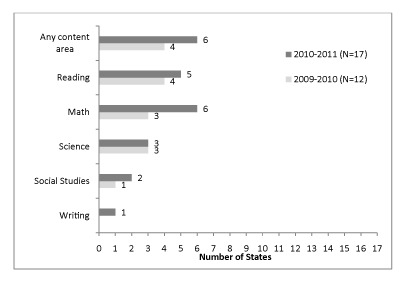
Similar to the previous report that
tracked CBTs, states that offered CBTs
for their AA-MAS provided varying
amounts of information and details
regarding the computer-based assessment
option in publicly available state
documents. All of the states provided
information about what content areas had
CBTs. Most of the states provided
information about accommodations for
students taking the AA-MAS via CBTs. For
example, Virginia shared:
If a student's Individualized Education
Plan (IEP) includes accommodations,
those accommodations should be provided
during the VMAST practice test, if
possible. If a student's accommodation
includes an audio assessment, the
practice test should be read aloud to
the student. Audio copies of these
assessments are not available at this
time.
A few states provided information
regarding test setting and test
administration schedule for their CBTs.
Connecticut, Minnesota and North Dakota
each provided detailed specifications of
test settings. Connecticut stated that
"students assessed with the CMT MAS must
be tested in a separate setting from
students assessed with the standard
CMT." North Dakota indicated that the
NDAA2 needs to be taken "on a computer
in a quiet, secure area free of
distractions, with direct supervision."
Minnesota stated that the "design of the
Minnesota MCA and MCA-Modified allows
students in the same physical setting to
take either test and provides seamless
administration for the student and
teacher—regardless of which test the
student is taking."
Connecticut, Maryland, and Minnesota had
different procedures for their AA-MAS
test administration schedules. For
example, Connecticut indicated that
"within a school, each test session on
the CMT MAS must be administered on the
same schedule to students in the same
grade," and that "there is no
requirement that CMT MAS test sessions
be administered on the same schedule as
the standard CMT for mathematics or
reading." Maryland stated that ‘online
tests are administered according to a
flexible administration schedule set by
each LEA within the overall
State-mandated HSA testing window."
Minnesota indicated that "scheduling for
the online Mathematics MCA and
MCA-Modified may be arranged around
computer availability, allowing an
entire class of students to pause their
administration at different points in
the assessment and returning to complete
it at a later time."
Some of the states also provided
students with tutorials and practice
tests for the AA-MAS CBTs. Figure 5
shows the number of states out of the
total of six that offered CBTs in
2010-2011 that have online tutorials and
practice tests available. Kansas,
Maryland, and Minnesota provided
tutorials to students. One state (North
Dakota) had a tutorial aimed
specifically at teachers rather than
students, and a few states also
suggested teachers review the student
tutorials or practice tests to
familiarize themselves with the test
format.
Connecticut, Kansas, Maryland,
Minnesota, and Virginia offered practice
tests for students to learn the computer
platform and accessibility features of
the CBTs. The type of practice tests
available varied by state. For example,
Connecticut offered practice tests for
each content area but they were not
grade specific. Kansas and Minnesota
both offered practice test items for
each content area and grade level.
Minnesota specified for each grade for
the mathematics assessment that, "The
purpose of the item samplers is to
familiarize students with the online
MCA-Modified test format."
Figure 5. Online Tutorials and Practice
Tests for States' Computer-based Tests
for the AA-MAS in 2011
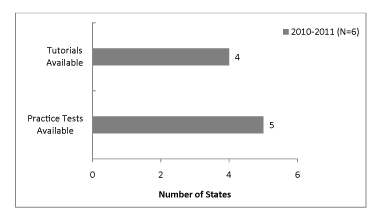
&
English Language Learners
In the previous report, documents from
six states (California, Connecticut,
Louisiana, Michigan, North Carolina, and
Texas) suggested the needs of ELLs
participating in the AA-MAS were
considered. In the current report, nine
states (California, Connecticut,
Louisiana, Maryland, Michigan,
Minnesota, North Carolina, Pennsylvania,
and Texas) provided information related
to ELLs participating in the AA-MAS. /p>
Similar to the previous report, Texas
continued to provide Linguistically
Accommodated Testing (LAT)
administrations of the TAKS-M for
eligible ELLs. In the current report,
Pennsylvania offered a Spanish version
of the PSSA-M for mathematics and it was
available as an accommodation for some
ELLs. Pennsylvania specified:
A Spanish version of each Mathematics
PSSA, PSSA-M, Science PSSA, Science
PSSA-M, Algebra, and Biology Keystone
paper/pencil exams is available for
students who have been enrolled in
schools in the United States for fewer
than three years…It is recommended that
Spanish language students be literate in
their native language for this
accommodation to be beneficial. However,
the Spanish-language version of the
assessment may be read aloud to an
eligible ELL student who can benefit
from receiving the assessment in Spanish
(for example, an ELL with prior
education in Spanish who is also
dyslexic).
In the 2009-2010 report, three states
(Louisiana, Michigan, and Texas)
specified which accommodations an
English language learner participating
in an AA-MAS may be eligible to use. In
2010-2011, seven states (California,
Louisiana, Maryland, Michigan,
Minnesota, Pennsylvania, and Texas)
included considerations about
accommodations for ELLs participating in
this assessment option. Table B8 in
Appendix B provides details (see
Lazarus, Cormier, Crone, & Thurlow,
2010, for general information about
AA-MAS accommodations policies).
Top of page |
Table of Contents
Discussion
In the 2010-2011 school year, 17
states had an assessment they considered
to be an AA-MAS. Fourteen states had an
operational assessment across all
content areas, while three states were
in the process of developing their
assessment. Four states (Kansas,
Louisiana, North Carolina, and Texas)
had completed the U.S. Department of
Education's Peer Review process. Other
key findings include:
- Similar to 2009-2010, all states
included multiple choice items in at
least one content area of the
AA-MAS. The number (and percentage)
of states using constructed response
items decreased from four states in
2009-2010 (33%) to three states in
2010-2011 (18%). In both years only
one state used performance tasks.
The number of states with writing
prompts remained the same as the
previous report (n = 5), but the
percentage of states with prompts
decreased to 29% from 42%.
- At least half of the states in
the current report incorporated the
following test design features into
the AA-MAS: additional graphics,
additional white space, distractor
removed, embedded
formulas/conversions, fewer items,
fewer items/page, key text
underlined/bolded/bulleted, larger
font size, one column format,
segmenting of passages, shorter
passages, simplified graphics,
and simplified language.
- The largest increase of a
tracked test design feature was
observed for simplified language
(94% in 2010-2011 from 58% in
2009-2010).
- Six states had developed
computer-based tests (CBTs) for at
least one content area of the AA-MAS
in 2010-2011 in comparison to four
states in 2009-2010. All of the six
states had developed a mathematics
CBT and five states also had a
reading CBT. One state (Kansas)
offered CBTs across all of its
available content areas, including
reading, writing, math, science, and
social studies.
- Nine states addressed
considerations for ELLs with
disabilities on the AA-MAS.
Some of the design changes made by
states on their AA-MAS are features that
are very similar to characteristics that
would be found on any test that was
developed using principles of universal
design (Thompson, Johnstone, Anderson, &
Miller, 2005; Thompson, Johnstone, &
Thurlow, 2002). The results suggest that
some states approached the design
changes for their AA-MAS from a
universal design perspective. For
example, one state (Minnesota)
specifically stated in developing test
items that the items were written using
principles of universal design and test
developers were directed to apply
language simplification techniques
(e.g., use high-frequency, familiar
vocabulary, active voice, and avoid
negation), and page and item layout
techniques (e.g., use a single column
format, and simple, uncluttered
graphics).
Specifications for test design
changes continued to vary by state in
the current report in comparison to the
2009-2010 report. Some states provided
more specific details for a design
change while other states provided more
general information. For some design
changes, different states implemented
the change in very different ways. For
example, states that simplified the
language of their AA-MAS often did so in
unique ways. Some states opted to
eliminate extraneous information, reduce
the reading load, reword complex
sentences, simplify sentence structure,
or change passive voice to active voice,
and other states broadly stated
language, vocabulary, or text was
simplified.
As states continue to develop and
revise their AA-MAS, they may want to
consider more specifically defining how
a design feature is used and provide
examples of specific design changes. For
example, a few states provided item
samplers for each grade and content area
that specifically went over what design
changes and modifications were made to
each question. One state (Pennsylvania)
indicated that their item samplers "may
be used as examples for creating
assessment items at the classroom
level." Providing materials such as item
samplers may make it easier for
educators to provide opportunities for
students who take the AA-MAS to gain
experience in using the test design
changes well before test day. This
follows good practices in connecting
instruction with accountability
assessments (Pugalee & Rickelman, 2010).
When we conducted this analysis we
found that states provided much more
detailed information regarding CBTs than
in past years. For example, a few states
addressed issues regarding test setting
and test administration schedules. This
year most states with computer-based
AA-MAS now had tutorials and practice
items as well as instructions about how
these materials should be looked at
prior to test day so that students can
learn how to navigate the test platform.
These tutorials and practice items can
be very helpful. According to Thurlow,
Lazarus, Albus, and Hodgson (2010),
providing training opportunities for
teachers and students to learn the
computer-based test platform is an
important part of ensuring that students
benefit from the accessibility features
and test design characteristics of the
test.
It is anticipated that federal
regulations and policies regarding the
AA-MAS may change in the future. Also,
many states are members of the
Race-to-the-Top Assessment Consortia and
are in the process of developing new
assessment systems based on common-core
standards. NCEO will continue to track
states as they make changes regarding
the AA-MAS and continue to seek how to
best assess low-performing students with
disabilities.
Top of page |
Table of Contents
References
Albus, D., Lazarus, S. S., Thurlow, M. L., & Cormier, D.
(2009). Characteristics of states' alternate assessments
based on modified academic achievement standards in 2008
(Synthesis Report 72). Minneapolis, MN: University of Minnesota,
National Center on Educational Outcomes.
Hodgson, J. R., Lazarus, S. S., &
Thurlow, M. L. (2010).
Characteristics of states' alternate
assessments based on modified academic
achievement standards in 2009-2010
(Synthesis Report 80). Minneapolis, MN:
University of Minnesota, National Center
on Educational Outcomes.
Lazarus, S. S., Cormier, D. C.,
Crone, M., & Thurlow, M. L. (2010).
States' accommodations policies for
alternate assessments based on modified
achievement standards (AA-MAS) in 2008
(Synthesis Report 74). Minneapolis MN:
University of Minnesota, National Center
on Educational Outcomes.
Lazarus, S. S., Hodgson, J., Price,
L. M., & Thurlow, M. L. (2011).
States' participation guidelines for the
alternate assessment based on modified
achievement standards (AA-MAS) in 2010
(Synthesis Report 82). Minneapolis MN:
University of Minnesota, National Center
on Educational Outcomes.
Lazarus, S. S., Thurlow, M. L.,
Christensen, L., & Cormier, D. (2007).
States' alternate assessments based
on modified achievement standards
(AA-MAS) in 2007 (Synthesis Report
67). Minneapolis MN: University of
Minnesota, National Center on
Educational Outcomes.
Pugalee, D. K., & Rickelman, R. J.
(2010). Understanding the content: A
focus on reading and mathematics. In M.
Perie (Ed.), Teaching and assessing
low-achieving students with
disabilities: A guide to alternate
assessments based on modified
achievement standards (pp. 113-148).
Baltimore, MD: Brookes Publishing.
Thompson, S. J., Johnstone, C. J.,
Anderson, M. E., & Miller, N. A. (2005).
Considerations for the development
and review of universally designed
assessments (Technical Report 42).
Minneapolis, MN: University of
Minnesota, National Center on
Educational Outcomes.
Thompson, S., Johnstone, C. J., &
Thurlow, M. L. (2002). Universal
design applied to large scale
assessments (Synthesis Report 44).
Minneapolis, MN: University of
Minnesota, National Center on
Educational Outcomes.
Thurlow, M., Lazarus, S. S., Albus,
D., & Hodgson, J. (2010).
Computer-based testing: Practices and
considerations (Synthesis Report
78). Minneapolis, MN: University of
Minnesota, National Center on
Educational Outcomes.
U.S. Department of Education (2007,
April 9). Final Rule 34 CFR Parts
200 and 300: Title I-Improving the
Academic Achievement of the
Disadvantaged; Individuals with
Disabilities Education Act (IDEA).
Federal Register. 72(67), Washington DC:
Author. Retrieved from
http://cehd.umn.edu/NCEO/2percentReg/FederalRegApril9TwoPercent.pdf
Top of page |
TTable of Contents
Appendix A
State Documents and Presentations
Used in the Analysis of States' AA-MAS
|
California
|
California
Department of Education.
(2010). 2011 standardized
testing and reporting item and
estimated time charts. Retrieved
from
http://www.cde.ca.gov/ta/tg/sr/documents/itemtime2011.doc
California
Department of Education. (2010).
Allowable testing variations and
accommodations for the 2010
California modified assessment.
Retrieved from
http://www.startest.org/pdfs/CMA.acc_table.2010.doc
California
Department of Education.
(2007). Differences between CST
and CMA.
Retrieved from
http://www.cde.ca.gov/be/ag/ag/yr07/documents/bluenov07
item14a6.pdf
California
Department of Education.
(2010). Student participation in
statewide assessments: CMA
updates. Retrieved from
http://www.cde.ca.gov/sp/se/sr/documents/cmaslides.ppt
California
Department of Education.
(2010). Testing variations,
accommodations, and
modifications. Retrieved from
http://www.cde.ca.gov/ta/tg/sa/documents/matrix2010.doc
|
|
Connecticut
|
Connecticut
State Department of Education.
(2010). Connecticut academic
performance test modified
assessment system (CAPT MAS)
fact sheet. Retrieved from
http://www.csde.state.ct.us/public/cedar/assessment/mas/resources/CAPTMAS%20Overview%209-16-10FINAL.pdf
Connecticut
State Department of Education.
(2010). Connecticut academic
performance test modified
assessment system: What grade 10
students and their parents
should know about the CAPT MAS.
Retrieved from
http://www.csde.state.ct.us/public/cedar/ass
essment/capt/resources/misc_capt
/2011%
20CAPT%20MAS%20Brochure.pdf
Connecticut
State Department of Education.
(2010). Connecticut academic
performance test third
generation 2011 test
coordinator's manual. Retrieved
from http://www.csde.stat
e.ct.us/public/cedar/assessment/capt/resources/misc_capt/2011%20CAPT%20TCM.10.pdf
Connecticut
State Department of Education.
(2009). Connecticut mastery test
and Connecticut academic
performance modified assessment
system. Retrieved from
http://www.csde.state.ct.us/public/cedar/assessment/common/MAS2010memo.pdf
Connecticut
State Department of Education.
(2010).Connecticut mastery test
fourth generation 2011 test
coordinator's manual Retrieved
from
http://www.csde.state.ct.us/pu blic/cedar/assessment/cmt/resources/misc_cmt/Test%20Coordinators%20Manual%202011.pdf
Connecticut
State Department of Education.
(2010). Connecticut mastery test
modified assessment system (CMT
MAS) fact sheet. Retrieved from
http://www.csde.state.ct.us/
public/cedar/assessment/mas/resources/CMTMAS%20Overview91610%20FINAL.pdf
|
|
Georgia
|
Georgia
Department of Education.
(2011). Criterion-referenced
competency test – modified
(CRCT-M): Frequently asked
questions. Retrieved from
http://www.gadoe.org/DMGetDocument.aspx/CRCTM%20FAQ%20Final.pdf?p=6CC6799F8C1371F63D85061BB034DD3E806674
BE2220174100F3A3D6586C5C0D&Type=D
Georgia
Department of Education.
(2011). Georgia
criterion-referenced competency
tests Spring 2011: Test
examiner's manual. Retrieved
from http://gadoe.org/DMGetDoc
ument.aspx/CRCT%20TEM%20Spring%202011%20Gr%2038.pdf?p=6CC6799F8C1371F630EF1EB06F4F07ABA2A31162
E574370804445CAE7285FFE5&Type=D
Georgia
Department of Education.
(2010). Questions and answers
about the criterion-referenced
competency tests – modified
(CRTC-M). Retrieved from
http://www.doe.k12.ga.us/DMGetDocument.aspx/CRCTM%20Brochure.pdf?p=6CC6799F8C1371F67243F842E9BDF8E477
55FE4566E46CE94495C2955C63B53A&Type=D
Georgia
Department of Education.
(2010). Sample items: Grade 3
English/language arts [also
grades 4-8]. Retrieved from
http://www.doe.k12.ga.us/ci_testing.aspx?folderID=
62163&m=links&ft=CRCTM Test
Items
Georgia
Department of Education.
(2010). Sample items: Grade 3
mathematics [also grades 4-8].
Retrieved from
http://www.doe.k12.ga.us/ci_testing.aspx?folderID=62163&
m=links&ft=CRCTM Test Items
Georgia
Department of Education.
(2010). Sample items: Grade 3
reading [also grades 4-8].
Retrieved from
http://www.doe.k12.ga.us/ci_testing.aspx?folderID=62163&m=links&
ft=CRCTMTestItems
Georgia
Department of Education.
(2010). Student Assessment
Handbook CRCT-M Addendum.
Retrieved from
http://www.gadoe.org/DMGetDocument.aspx/Student%20A
ssessment%20Handbook%20CRCTM%20Addendum.doc?p=6CC6799F8C1371F6BA8651CA687D9D1CF02564EAD38DE13327BDF56AD8311020&Type=D
|
|
Indiana
|
Indiana
Department of Education.
(2010). 2010-2011 ISTEP+ program
manual: Policies and procedures
for Indiana's assessment system.
Retrieved from
http://www.doe.in.gov/assessment/docs/ProgramManual.pdf
Indiana
Department of Education.
(2010). IMAST English/language
arts sample items (grades 3-5)
[also for grades 6-8]. Retrieved
from
http://www.doe.in.gov/assessment/
imast_resources.html
Indiana
Department of Education.
(2010). IMAST mathematics sample
items (grades 3-5) [also for
grades 6-8]. Retrieved from
http://www.doe.in.gov/assessment/imast_resour
ces.html
Indiana
Department of Education.
(2010). IMAST science sample
items (grades 4, 6). Retrieved
from
http://www.doe.in.gov/assessment/docs/IMAST_Item_Sampler_SCI_4-6.pdf
Indiana
Department of Education.
(2010). IMAST social studies
sample items (grades 5, 7).
Retrieved from
http://www.doe.in.gov/assessment/docs/IMAST_Item_Sampler_SS_5-7.pdf
|
|
Kansas
|
Kansas State
Department of Education.
(2010). 2010-2011 Kansas
assessment examiner's manual.
http://www.ksde.org/Default.aspx?tabid=420#EXMAN
Kansas State
Department of Education.
(2009). Arctic terns. Retrieved
from
http://www.ksde.org/LinkClick.aspx?fileticket=6tEFroUmoI%3d&tabid=23
71&mid=8893
Kansas State
Department of Education.
(2009). Camping at whispering
woods. Retrieved from
http://www.ksde.org/LinkClick.aspx?fileticket=n9SIo5qlKQ%3d&tabid=
2371&mid=8893
Kansas State
Department of Education.
(2009). Kansas assessment with
modified measures (KAMM)
calculator use. Retrieved from
http://www.ksde.org/LinkClick.aspx?fi leticket=doGB_6_Enpc%3d&tabid=2371&mid=8892
Kansas State
Department of Education.
(2010). Kansas assessment of
modified measures: Writing
assessment for students with
disabilities Q & A. Retrieved
from
http://www.ksde.org/LinkClick.aspx?fileticket=jr5Hqvci-tU%3D&tabid=2371&mid=8891
Kansas State
Department of Education.
(2010). Kansas curricular
standards for reading education.
Retrieved from
http://www.ksde.org/LinkClick.aspx?fileticket=D2XDTMR7y30
%3d&tabid=2371&mid=8894
Kansas State
Department of Education.
(2010). Kansas
history-government assessment
fact sheet 2010-2011. Retrieved
from
http://www.ksde.org/Default.aspx?tabid=2364=-
Kansas State
Department of Education.
(2010). Kansas writing
assessment factor sheet
2010-2011. Retrieved from
http://www.ksde.org/Default.aspx?tabid=2364
Kansas State
Department of Education.
(2009). Kodiak Island. Retrieved
from
http://www.ksde.org/LinkClick.aspx?fileticket=Px1n-s1QarY%3d&tabid=2371&mid=8893
Kansas State
Department of Education.
(2009). Make a musical
instrument. Retrieved from
http://www.ksde.org/LinkClick.aspx?fileticket=9dgreZUT2gI%3d&tabid=2371&mid=
8893
Kansas State
Department of Education.
(2009). Questions about the
2009-2010 Kansas assessment of
modified measures (KAMM).
Retrieved from
http://www.ksde.org/LinkClick.aspx?fileticket=mXWLVp-jvFI%3d&tabid=2371&mid=8892
Kansas State
Department of Education.
(2007). Sample problems
illustrative of items based on
modified academic achievement
standards. Retrieved from
http://www.ksde.o rg/LinkClick.aspx?fileticket=WGqaR6EvQ2k%3d&tabid=2371&mid=8893
The Center for
Educational Testing &
Evaluation. (2011). Welcome
page for Kansas assessment
programs.
Retrieved from
http://www.cete.us/kap/
|
|
Louisiana
|
Louisiana
Department of Education.
(2010). 2009-2010 annual report:
LEAP alternate assessment, level
2.
Retrieved from
http://doe.louisiana.gov/lde/uploads/17589.pdf
Louisiana
Department of Education.
(2010). A parent's guide: LEAP
alternate assessment, Level 2
(LAA2):
Retrieved from
www.doe.state.la.us/lde/uploads/13500.pdf
Louisiana
Department of Education.
(2009).Interpretive guide: LEAP
alternate assessment, Level 2.
Retrieved from
http://doe.louisiana.gov/lde/uploads/9731.pdf
Louisiana
Department of Education.
(2008). LAA2 LEAP alternate
assessment, level 2, assessment
guide: English language arts and
mathematics (grades 4, 8, 10)
science and social studies
(grades 4, 8, 11). Retrieved
from
http://doe.louisiana.gov/lde/uploads/8524.pdf
Louisiana
Department of Education.
(2009). LAA2 test administration
manual: English language arts,
mathematics, science, social
studies.
Retrieved from
http://www.doe.state.la.us/lde/uploads/15136.pdf
Louisiana
Department of Education.
(2010). LAA2 test administration
manual: English language arts,
mathematics, science, social
studies (grades 10, 11).
Retrieved from
http://doe.louisiana.gov/lde/uploads/17031.pdf
Louisiana
Department of Education.
(2010). LEAP and GEE test
administration manual.
Retrieved
from
www.doe.state.la.us/lde/uploads/15311.pdf
|
|
Maryland
|
Maryland State
Department of Education.
(2008). English: HSA public
release items compared to
Mod-HAS public release items
[also for biology, government,
algebra/data analysis].
Retrieved from
http://docushare.msde.state.md.us/docushare/dsweb/View/C
ollection-15814
Maryland State
Department of Education.
(2008). High school assessment:
Algebra/data analysis. [also
Biology, English, Government].
Retrieved from
http://mdk12.org/assessments/high_school/look_like/
Maryland State
Department of Education.
(n.d.). HSA: High school
assessment program.
Retrieved
from
http://mdk12.org/assessments/high_school/index_d2.html
Maryland State
Department of Education.
(n.d.). Maryland modified school
assessment (Mod-MSA).
Retrieved
from
http://mdk12.org/assessments/mod_ msa/index.html
Maryland State
Department of Education.
(2011). Overview of the 2009
Maryland school
assessment-Mathematics.
Retrieved from
http://www.marylandpublicschools.org/NR/rdo
nlyres/A8EB4B5CB116466F9EA46AEDAC06C943/27317/
2009_MSA_Math_TechReport_Final_SECTION_1.pdf
Maryland State
Department of Education.
(2011). Overview of the 2009
Maryland school
assessment-Reading. Retrieved
from
http://www.marylandpublicschools.org/NRrdonlyr es/1656DB524FE141CCBD9CC4C2AECC8944/27300/
2009_MSA_Reading_TechReport_Final_1_OVERVIEW.pdf
Maryland State
Department of Education.
(2011). Practice assessment
tools. Retrieved from
http://www.pearsonaccess.com/cs/Satellite?c=Page&childpagename=Maryland%2 FmdPALPLayout&cid=
1175826727300&pagename=mdPALPWrapper
Maryland State
Department of Education.
(2008). Practice test for
Mod-HSA Algebra/data analysis
[also Biology, English,
Government].
Retrieved from
http://mdk12.org/assessments/high_school/index.html
|
|
Michigan
|
Michigan
Department of Education.
(2009). Assessment accommodation
summary table. Retrieved from
http://www.michigan.gov/documents/mde/Updated_Revised_Accommod
ation_Summary_Table_092909_294052_7.pdf
Michigan
Department of Education.
(2009). MEAP-Access coordinator
and assessment administrator
manual: Winter 2009 pilot.
Retrieved from
http://www.michigan.gov/docum
ents/mde/09_MEAP_Access_Pilot_CAAM_011309Final_263081_7.pdf
Michigan
Department of Education.
(2009). MEAP-Access fall 2009
webcast. Retrieved from
http://www.michigan.gov/documents/mde/F09_MEAPAccess_Webcast_091609__
293307_7.ppt
Michigan
Department of Education.
(2011). MEAP-Access frequently
asked questions. Retrieved from
http://www.michigan.gov/documents/mde/MEAP-Access_FAQ_12-1-0_
339709_7.pdf
Michigan
Department of Education.
(2011). MEAP-Access OEAA/OSE-EIS
Webcast Powerpoint. Retrieved
from
http://www.mistreamnet.com/docs/downdockit.php?what=MI-Access_030911.ppt
Michigan
Department of Education.
(2011). MEAP-Access Spring 2011
webcast.
Retrieved from
http://www.mistreamnet.com/vidflv.php?who=mde030911
Michigan
Department of Education.
(2009). MEAP-Access test
administrator manual.
Retrieved
from
http://www.michigan.gov/documents/mde/MEAPAccess_Test_Administ
rator_Manual-Online_Version_290878_7.pdf
Michigan
Department of Education. (2011).
Michigan Statewide
Assessment Selection Guidelines.
Retrieved from
http://www.michigan.gov/documents/mde/ASG_Manual_FINAL_2010-11_347154_7.pdf
|
|
Minnesota
|
Minnesota
Department of Education.
(2011). 2011 Title 1 Assessment
Manual. Retrieved from
http://education.state.mn.us/mdeprod/groups/Assessment/documents/Manual/
033825.pdf
Minnesota
Department of Education.
(2010). Draft Mathematics test
specifications for MCA-III,
grades 3-8 and MCA-modified,
grades 5-8. Retrieved from
http://education.state.mn.us/mdeprod/idcplg?IdcService=GET_FILE&dDocName=034627&
RevisionSelectionMethod=latestReleased&Rendition=primary
Minnesota
Department of Education.
(2010). Draft test
specifications for mathematics,
grade 11. Retrieved from
http://education.state.mn.us/mdeprod/idcplg?IdcService=GET_FILE&dDocName=018196&RevisionSelection
Method=latestReleased&Rendition=primary
Minnesota
Department of Education.
(2010). Draft test
specifications for reading.
Retrieved from
http://education.state.mn.us/mdeprod/idcplg?IdcService=GET_FILE&d
DocName=018194&RevisionSelectionMethod
=latestReleased&Rendition=primary
Minnesota
Department of Education.
(2011). Mathematics MCA-modified
grade 8 item sampler teacher
guide. Retrieved from
http://www.pearsonaccess.com/cs/Satellite?c=Pa ge&childpagename=Minnesota%2FmnPALPLayout&cid=1205461255328&p=1205461255328&pagename=mnPALPWrapper&resourcecategory=Item+Samplers
Minnesota
Department of Education.
(2011). MCA mathematics grade 7
teacher guide. Retrieved from
http://www.pearsonaccess.com/cs/Satellite?c=Page&childpagename=
Minnesota%2FmnPALPLayout&cid=1205461255328&p=1205461255328&pagename=mnPALPWrapper&resourcecategory=Item+Samplers
Minnesota
Department of Education.
(2011). Minnesota comprehensive
assessments-modified:
Mathematics item sampler grade
11. Retrieved from
http://education.state.mn.us/MDE/Accountability_Programs/Assessment_and_
Testing/
Assessments/Alternate/
Alternate_Item_Samplers/index.html
Minnesota
Department of Education.
(2010). Minnesota comprehensive
assessments-series II:
Mathematics item sampler grade
11. Retrieved from
http://education.state.mn.us/MDE/Accountability_Programs/Assessment_and_Testing/Assessments/MCA/Samplers/index.html
Minnesota
Department of Education.
(2011). Minnesota comprehensive
assessments-modified: Reading
item sampler grade 5 [also
grades 6-8 and 10]. Retrieved
from
http://education.state.mn.us/MDE/Accountability_Programs/Assessment_and_Testing/Assessments/Alternate/
Alternate_Item_Samplers/index.html
Minnesota
Department of Education.
(2010). Minnesota comprehensive
assessments-series II: Reading
item sampler grade 5 [also
grades 6-8, 10]. Retrieved from
http://education.state.mn.us/MDE/Accountability_Programs/Assessment_and_Testing/Assessments/MCA/Samplers/index.html
Minnesota
Department of Education.
(2010). Procedures manual for
the Minnesota assessment
2010-2011. Retrieved from
http://education.state.mn.us/mdeprod/idcplg?Idc
Service=GET_FILE&dDocName=035664&RevisionSelectionMethod=
latestReleased&Rendition=primary
|
|
North Carolina
|
North Carolina
Department of Public
Instruction. (2008).
NCEXTEND2 assessments.
Retrieved
from
http://www.ncpublicschools.org/accountability/policies
/tswd/ncextend2
North Carolina
Department of Public
Instruction. (2008). Sample
items for the NCEXTEND2
EOG grade 3 mathematics
test [also grades 4-8].
Retrieved from
http://www.ncpublicschools.org/accountability/testing/eog/sampleitems/math
North Carolina
Department of Public
Instruction. (2008). Sample
items for the North Carolina EOG
grade 3 mathematics test [also
grades 4-8]. Retrieved from
http://www.ncpublicschools.org/accountability/testing/eog/sampleitems/math
North Carolina
Department of Public
Instruction. (2009). Testing
students with disabilities:
North Carolina testing program.
Retrieved from
http://www.ncpublicschools.org/docs/accountability/policyoperations/tswd/tswd.pdf
|
|
North Dakota
|
North Dakota
Department of Public
Instruction. (2010).
Comparison of NDAA-1 and NDAA-2.
Retrieved from
http://www.dpi.state.nd.us/speced/resource/alternate/side_by_
side.pdf
North Dakota
Department of Public
Instruction. (2010). North
Dakota Alternate Assessment – 2
(2009-2010): Technical Manual.
Retrieved from
http://www.dpi.state.nd.us/speced/resource/alternate/NDAA2_technical_manual.pdf
North Dakota
Department of Public
Instruction. (2010). North
Dakota alternate assessment 2:
2010-11 test directions manual.
Retrieved from
http://www.dpi.state.nd.us
/speced/resource/alternate/NDAA2_Test_Directions_Manual.pdf
North Dakota
Department of Public
Instruction. (2010). Three
sided (side-by-side-by-side)
comparison of the North Dakota
state assessment participation
options.
Retrieved from
http://www.dpi.state.nd.us/speced/resource/alternate/3_sides_
options.pdf
|
|
Ohio
|
Ohio Department
of Education. (2009). 2%
AA-MAS working group fall 2008
pilot study: Technical report.
Retrieved from
http://www.ode.state.oh.us/GD/DocumentManagement/
DocumentDownload.aspx?DocumentID=74516
Ohio Department
of Education. (2009). 2%
AA-MAS working group spring 2009
pilot study: Technical report.
Retrieved from
http://www.ode.state.oh.us/GD/DocumentMana gement/DocumentDownload.aspx?DocumentID=73925
Ohio Department
of Education. (2010). AA-MAS
development timeline. Retrieved
from
http://www.ode.state.oh.us/GD/DocumentManage ment/DocumentDownload.aspx?Docu
mentID=90304
Ohio Department
of Education. (2009).
Alternate assessment based on
modified achievement standards
(AA-MAS) practice test: English
language arts and mathematics.
Retrieved from
http://www.ode.state.oh.us/GD/DocumentManagement/DocumentDown load.aspx?DocumentID=73924
Ohio Department
of Education. (2010).
Alternate assessment based on
modified achievement standards
(AA-MAS): Test coordinator and
test administrator manual.
Retrieved from
http://www.ohiodocs.org/AAMAS/2009_2010/AAMAS_Spr10_Manual.pdf
Ohio Department
of Education. (2005). Ohio
achievement tests grade 7
mathematics. Student test
booklet: Half-length practice
tests.
Retrieved from
http://education.ohio.gov/
GD/DocumentManagement/DocumentDownload.aspx?DocumentID=4689
Ohio Department
of Education. (2005). Ohio
achievement tests grade 7
reading. Student test booklet:
Half-length practice tests.
Retrieved from
http://education.ohio.gov/GD/Doc umentManagement/DocumentDownload.aspx?DocumentID=4692
|
|
Oklahoma
|
Oklahoma State
Department of Education.
(2009). Oklahoma modified
alternate assessment program
(OMAAP).
Retrieved from
http://sde.state.ok.us/acctassess/pdf/
Presentations/OMAAP.ppt
Oklahoma State
Department of Education.
(2010). Oklahoma modified
alternate assessment program
(OMAAP) algebra I, parent,
student, and teacher guide [also
English II, Biology I, U.S.
History].
Retrieved from
http://sde.state.ok.us/acctassess/OMAAP.html
Oklahoma State
Department of Education.
(2011). Oklahoma modified
alternate assessment program
(OMAAP) mathematics & reading
grade 3, parent, student, and
teacher guide [also grades 5-7].
Retrieved from
http://sde.state.ok.us/acctassess/OMAAP.html
Oklahoma State
Department of Education.
(2011). Oklahoma modified
alternate assessment program
(OMAAP) mathematics, reading and
science grade 5, parent,
student, and teacher guide [also
grade 8].
Retrieved from
http://sde.state.ok.us/acctassess/OMAAP.html
Oklahoma State
Department of Education.
(2010). Oklahoma school testing
program core curriculum tests
end-of-instruction ACE algebra I
parent, students, and teachers
guide. [also Algebra II, English
II, English III, Biology I,
Geometry, U.S. History].
Retrieved from
http://sde.state.ok.us/AcctAssess/core.html
Oklahoma State
Department of Education.
(2011). Oklahoma school testing
program core curriculum tests
grade 3 mathematics and reading
parent, student, and teacher
guide [also grades 4-8].
Retrieved from
http://sde.state.ok.us/AcctAssess/core.html
Oklahoma State
Department of Education.
(2011). Oklahoma school testing
program core curriculum tests
online test administration
manual: Grade 7 geography. [also
grade 8 mathematics and reading,
Algebra I, Algebra II, Geometry,
Biology I, U.S. History, English
II, English III].
Retrieved from
http://sde.state.ok.us/acctassess/testadmin.html
|
|
Pennsylvania
|
Pennsylvania
Department of Education.
(2011). 2010-2011 assessment
handbook. Retrieved from
http://www.portal.state.pa.us/portal/http;//www.portal.state.pa.us;80/port
al/server.pt/gateway/PTARGS_0_123031_999720_0_0_18/
PSSA_Assessment_Handbook_2010-2011.pdf
Pennsylvania
Department of Education.
(2011). Accommodations
guidelines, PSSA, PSSA-M,
Keystone Exams, for English
language learners. Retrieved
from
http://www.portal.state.pa.us/portal/http;//www.portal.state.pa.us;80/portal/server.pt/gateway/
PTARGS_0_123031_1038658_0_0_18/Accommodations_for_ELLs_2011.pdf
Pennsylvania
Department of Education.
(2011). Pennsylvania state
assessments 2011. Retrieved from
http://www.portal.state.pa.us/portal/http;//www.portal.state.pa.us;80/port
al/server.pt/gateway/PTARGS_0_123031_994390_0_0_18/PSSA_Getting_Ready_Roll_Out_2011.pdf
Pennsylvania
Department of Education.
(2009). The Pennsylvania system
of school assessment:
Mathematics item and scoring
sampler 2009-2010 grade 4.
Retrieved from
http://www.education.state.pa.us/portal/server.pt/community/pennsylvania_system_of_school_
assessment_%28pssa%29/8757/resource_materials/507610
Pennsylvania
Department of Education.
(2009). The Pennsylvania system
of school assessment: Modified
mathematics item and scoring
sampler 2009-2010 grade 4 [also
Grades 5-8 and 11]. Retrieved
from
http://www.education.state.pa.us/portal/server.pt/
community/pennsylvania_system_of_school_assessment_%28pssa%29/8757/resource_materials/507610
Pennsylvania
Department of Education.
(2010). The Pennsylvania system
of school assessment: Modified
reading item and scoring sampler
2010-2011 grade 4 [also Grades
5-8 and 11] Retrieved from
http://www.education.state.pa.us/portal/server.pt/community/
pennsylvania_system_of_school_assessment_%28pssa%29/8757/resource_materials/507610
Pennsylvania
Department of Education.
(2010). The Pennsylvania system
of school assessment: Modified
science item and scoring sampler
2010-2011 grade 8 [also Grades
11] Retrieved from
http://www.education.state.pa.us/portal/server.pt/community/
pennsylvania_system_of_school_assessment_%28pssa%29/8757/resource_materials/507610
Pennsylvania
Department of Education.
(2010). PSSA-M: Assigning
students to the test and
understanding participation.
Retrieved from
http://www.portal.state.pa.us/portal/http;//www.portal.state.pa.us;80/portal/server.pt/gateway/
PTARGS_0_123031_994866_0_0_18/PSSA-M_Webinar_November_2010.pdfan>
|
|
Tennessee
|
Tennessee
Department of Education.
(2010). Modified academic
achievement standards
assessment: TCAP MASS 2010-2011.
Retrieved from
http://www.tennessee.gov/education/assessment/doc/MAAS_2010-11_ppt.pdf
Tennessee
Department of Education.
(2011). Modified academic
achievement standards: Teachers
directions spring 2011.
Retrieved from
http://www.state.tn.us/
education/assessment/doc/MAAS_Teacher_Dir_Spr2011_000.PDF
Tennessee
Department of Education.
(2009). Tennessee comprehensive
assessment program achievement
test: Grade 3 item sampler [also
grades 4-8]. Retrieved from
http://www.state.tn.us/education/assessment/ach
_samplers.shtml
Tennessee
Department of Education.
(2009). Tennessee comprehensive
assessment program modified
academic achievement standards:
Grade 3 item sampler [also
grades 4-8].
Retrieved from
http://www.state.tn.us/education/assessment/doc/MAAS_G3_Item
Sampler.pdf
Tennessee
Department of Education.
(2010). The 2% TCAP-MAAS and
standards-based IEPs: What are
they and how will they help us?
Retrieved from
http://www.state.tn.us/education/speced/doc/3609TCAPMAAS.ppt
|
|
Texas
|
Texas Education
Agency. (2010). An
explanation of test results for
2010: TAKS-M. Retrieved from
http://www.tea.state.tx.us/WorkArea/linkit.aspx?LinkIdentifier=id&Item
ID=2147489337&libID=2147489336
Texas Education
Agency. (2009). Released
TAKS tests [grade 3 reading].
Retrieved from
http://ritter.tea.state.tx.us/student.assessment/resources/online/2009/taks_g03_re
ad/3reading.html
Texas Education
Agency. (2009). Released
TAKS-M tests [grade 3 reading].
Retrieved from
http://www.tea.state.tx.us/index3.aspx?id=5298&menu_id=793
Texas Education
Agency. (2010). TAKS-M
general test administration
manual 2011, grades 3-11.
Retrieved from
http://www.tea.state.tx.us/student.assessment/special-ed/taksm/GenTAManual2011.pdf
Texas Education
Agency. (2009). TAKS-M
modification guidelines for
grades 3-11 reading/ELA [also
mathematics, social studies, and
writing]. Retrieved from
http://www.tea.state.tx.us/student.assessment/special-ed/taksm/guidelines/
Texas Education
Agency. (2009). TAKS-M
modification guidelines for
grades 5, 8, 10, and 11 science.
Retrieved from
http://www.tea.state.tx.us/student.assessment/special-ed/taksm/guidelines
Texas Education
Agency. (2010). TAKS-M test
administration directions, 2011,
grades 3-5 [also grades 6-8 and
grades 9-11].
Retrieved from
http://www.tea.state.tx.us/student.ass essment/special-ed/taksm/manuals/
Texas Education
Agency. (2007). Texas
assessment of knowledge and
skills-modified (TAKS-M)
blueprint for grade 3 reading
[also mathematics, science,
social studies, and writing].
Retrieved from http://www.tea.state.tx.us/student.assessment/specialed/taksm/blueprints/
Texas Education
Agency. (2002). Texas
Assessment of knowledge and
skills (TAKS): Blueprint for
grades 3-8 reading. Retrieved
from
http://www.tea.state.tx.us/index3.aspx?id=3228&menu_id=793
|
|
Virginia
|
Virginia
Department of Education.
(2010). Examiner's manual:
Virginia modified achievement
standards test, grade 3-8
mathematics & algebra I, spring
2011 field test. Retrieved from
http://www.doe.virginia.gov/testing/alternative_assessments/vmast_va_m od_achievement_stds_test/index.shtml
Virginia
Department of Education.
(2010). Examiner's manual:
Virginia modified achievement
standards test, grade 8 reading,
grade 8 mathematics, spring 2010
field test. Retrieved from
http://www.doe.virginia.gov/testing/alternative_assessments/vmast
_va_mod_achievement_stds_test/vmast_examiners_manual.pdf
Virginia
Department of Education.
(2010). Superintendent's memo
#114-10: Implementation schedule
for the Virginia modified
achievement standards test
(VMAST). Retrieved from
http://www.doe.virginia.gov/administrators/superintendents_memos
/2010/114-10.shtml
Virginia
Department of Education.
(2010). Superintendent's memo
#301-10: Nominations for 2011
Virginia modified achievement
standards test (VMAST) reading
item support committees.
Retrieved from
http://www.vate.org/pdf/board_meetings/VDOE%
20for%20
VATE%20Bd%201-08-2011.pdf
Virginia
Department of Education.
(2009). Technical innovations in
Virginia's assessment program.
Retrieved from
http://www.doe.virginia.gov/boe/meetings/2009
/04_apr/agenda_items/item_d.pdf
Virginia
Department of Education.
(2010). Virginia modified
achievement standards test
(VMAST) practice test manual.
Retrieved from
http://www.doe.virginia.gov/testing
/alternative_assessments/vmast_va_mod_achievement_stds_test/
vmast_practice_test_manual.pdf
Virginia
Department of Education.
(2009). Virginia modified
achievement standards test
[Webinar] .
Retrieved from
http://www.vdoe.whro.org/VMAST_05.28.09.wmv
Virginia
Department of Education. (2011).
VMAST practice items. Retrieved
from
http://www.doe.virginia.gov/testing/alternative_assessments/vmast_va_mod_achievement_stds_test/
practice_items/index.shtmlan>
|
Top of page |
TTable of Contents
Appendix B
AA-MAS Characteristics by State /h2>
Table B1. AA-MAS Name,
Content Area, and Grade Described by
State
|
State
|
Assessment
Name
|
Content
Areas/Grades
|
Notes
|
|
California
|
California
Modified Assessment (CMA)
|
Math (3-7);
English Language Arts (3-11);
Writing (4, 7); Science (5, 8);
Algebra I (7-111);
Geometry (8-111);
Life Science (10)
|
Operational
|
|
Connecticut
|
Connecticut
Mastery Test Modified Assessment
System (CMT MAS) and Connecticut
Academic Performance Test
Modified Assessment System (CAPT
MAS)
|
Math and Reading
(3-8, 102)
|
Operational
|
|
Georgia
|
Georgia
Criterion-Referenced Competency
Tests – Modified (CRCT-M)
|
Math and Reading
(3-8); English Language Arts
(3-8)
|
Operational
|
|
Indiana
|
Indiana Modified
Achievement Standards Test
(IMAST)
|
Math and English
Language Arts (3-8); Science (4,
6); Social Studies (5, 7)
|
Operational
|
|
Kansas3
|
Kansas
Assessment of Modified Measures
(KAMM)
|
Math and Reading
(3-8, HS); Writing (5, 8, HS);
Science (4, 7)
History-Government (9, 11)
|
Operational
|
|
Louisiana
|
Louisiana
Educational Assessment Program
(LEAP) Alternate Assessment,
Level 2
|
Math and English
Language Arts (4-8, 10-11);
Science (4, 8, 11); Social
Studies (4, 8, 11)
|
Operational
|
|
Maryland
|
Maryland
Modified High School Assessment
(Mod-HSA); Maryland Modified
School Assessment (Mod-MSA)
|
Math and Reading
(3-8); Algebra, Biology,
English, and Government (HS)
|
Operational
|
|
Michigan
|
Michigan
Educational Assessment Program
(MEAP) Access
|
Math and Reading
(3-8); Writing (4, 7)
|
Piloted Winter
2009. Operational by Fall 2011.
|
|
Minnesota
|
Minnesota
Comprehensive Assessment (MCA)
Modified
|
Math and Reading
(5-8, 10)
|
Operational as
of Spring 2011
|
|
North Carolina
|
NCEXTEND2
Alternate Assessment for
End-of-Grade (EOG)
|
Math and Reading
(3-8); Science (5, 8)
|
Operational
|
|
North Dakota
|
North Dakota
Alternate Assessment 2 (NDAA2)
|
Math and
Reading/Language Arts (3-8, 11);
Science (4, 8, 11)
|
Operational
|
|
Ohio
|
Ohio's Alternate
Assessment based on Modified
Achievement Standards (AA-MAS)
|
Math and Reading
(5-8, 10)
|
Ohio's AA-MAS
was field tested in spring 2010
and is continuing with pilot
testing in 2012.
|
|
Oklahoma
|
Oklahoma
Modified Alternate Assessment
Program (OMAAP)
|
Math and Reading
(3-8); Science (5, 8);
End-of-Instruction Tests, High
School (Algebra I, Biology I,
English II, and U.S. History)
|
Operational
|
|
Pennsylvania
|
Pennsylvania
System of School
Assessment-Modified (PSSA-M)
|
Math and Reading
(4-8, 11); Science (8, 11)
|
Operational
|
|
Tennessee
|
Tennessee
Comprehensive Assessment Program
(TCAP) Modified Academic
Achievement Standards (MAAS)
|
Math and
Reading/Language Arts (3-8);
Science (3-8); Social Studies
(3-8)
|
Operational
|
|
Texas
|
Texas Assessment
of Knowledge and Skills Modified
(TAKS-M)
|
Math (3-11);
Reading (3-9); English Language
Arts (10-11); Writing (4, 7)
Science (5, 8, 10-11); Social
Studies (8, 10, 11)
|
Operational
|
|
Virginia
|
Virginia
Modified Achievement Standards
Test (VMAST)
|
Math and Reading
(3-8); Algebra 1 (End-of-Course)
|
Virginia's Math
tests will be field tested in
spring 2011 and are expected to
be operational by 2011-2012.
Virginia's reading tests will be
field tested in spring 2012 and
are expected to be operational
by the 2012-2013 school year.
|
1
Students will complete the assessment
during one of the school years
mentioned.
2
CAPT MAS is available as a live test for
identified grade 10 students and as a
retest for individual students in grade
11 and 12.
3
Kansas offers KAMM Opportunity to Learn
(OTL) assessments for grades 9-12 in
math, reading, science, writing, and
history-government. The OTL assessments
are designed to give students the
opportunity to learn the content
standards prior to participation in the
KAMM. According to the Kansas Assessment
Examiner's Manual this assessment option
"provides High Schools with flexibility
in determining when to assess students."
Table B2. Assessment Type and
Question Characteristic by Content Area
for States' AA-MAS, 2011
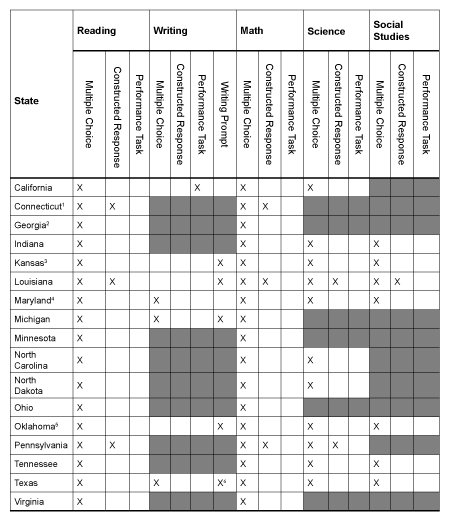
Note: Shading
indicates a state does not have a
separate assessment for that content
area.
1
Connecticut's Mastery Test Modified
Assessment System (CMT MAS) and
Connecticut's Academic Performance Test
(CAPT) Modified Assessment System (MAS)
are both available for Reading and
Mathematics.
2Georgia
has separate tests for both
English/Language Arts and Reading in
grades 3 to 8.
3 Kansas
offers a general and KAMM writing
assessment that are available some years
but are not available for the 2010-2011
year.
4 No
information on question characteristics
found for Maryland Modified School
Assessment (Mod-MSA). Maryland Modified
High School Assessment (Mod-HSA) covers
the following content areas: Algebra,
Biology, English, and Government.
5 The
English II EOI Modified Assessment had
40 multiple choice items and one writing
prompt. Students eligible for the OMAAP
in grades 5 and 8 must take the general
writing assessment. Likewise, students
eligible for the OMAAP in grades 5, 7,
and 8 must take the general assessment
for social studies, geography, and U.S.
History, Constitution, and Government.
6 TAKS-M
includes a writing prompt for students
taking the Writing tests in grades 4 and
7, as well as students in grades 10 and
11 taking the English Language Arts
(ELA) test.
Table B3. Comparison of
AA-MAS and Regular Assessment: Design
Changes, 2011
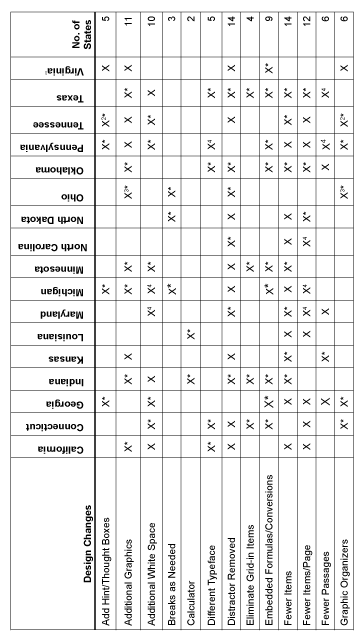
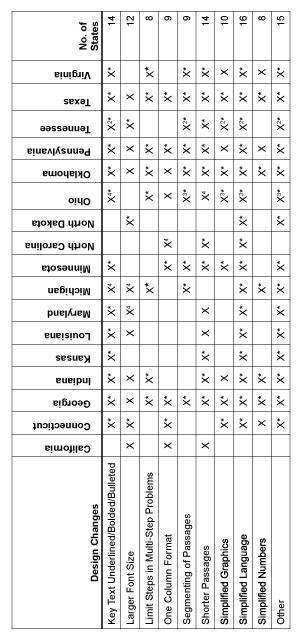
figb3
*See Table B4 for
specifications and for descriptions of
"other" design changes.
1Virginia
identified "potential supports and
scaffolds" to be used on the VMAST.
2 Tennessee
identified "possible" design changes for
the TCAP MAAS.
3 Indicates
design change on Ohio's AA-MAS Spring
2009 pilot and Fall 2008 pilot.
4 Indicates
design change identified via visual
comparison of AA-MAS and regular
assessment item samplers. The change was
not explicitly identified in state
documents.
Table B4. Specifications and
Descriptions of Assessment Design
Changes and of "Other" Assessment Design
Changes, 2011

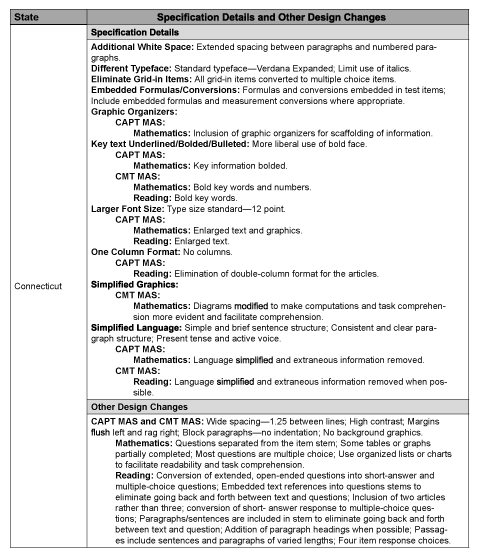
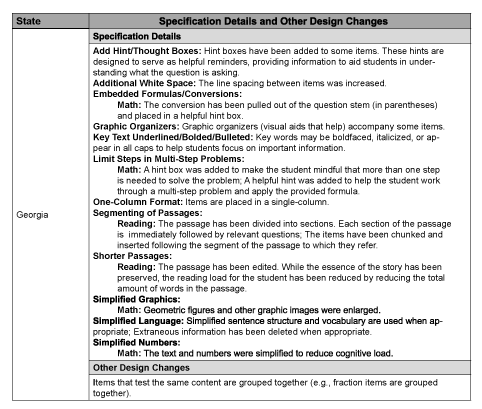
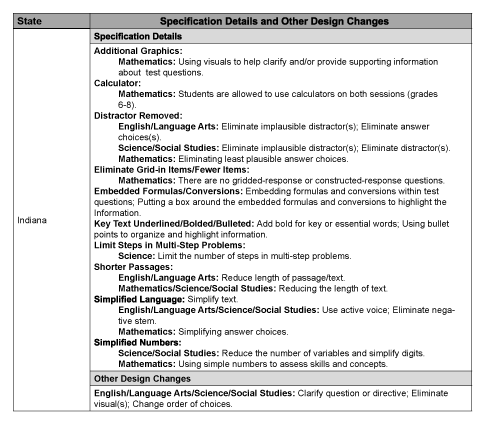
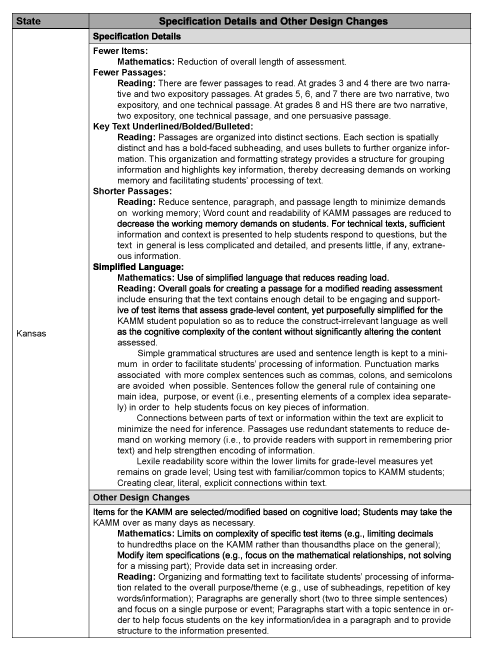
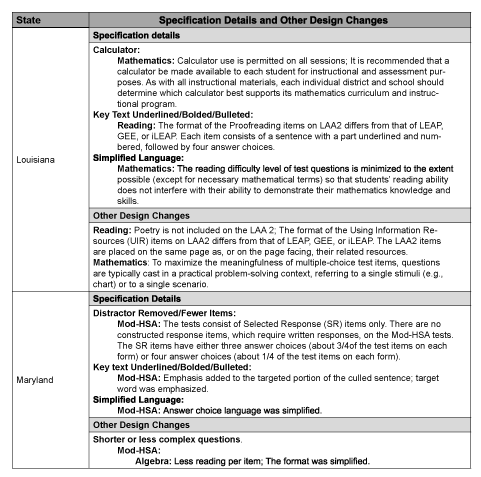
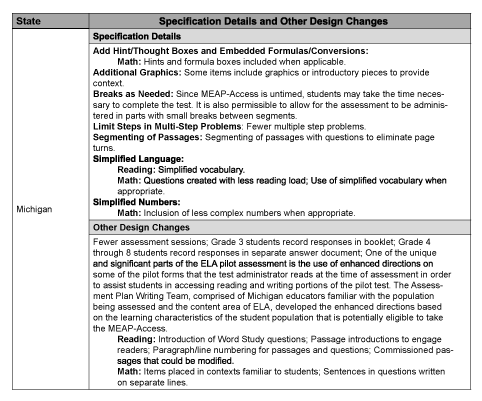
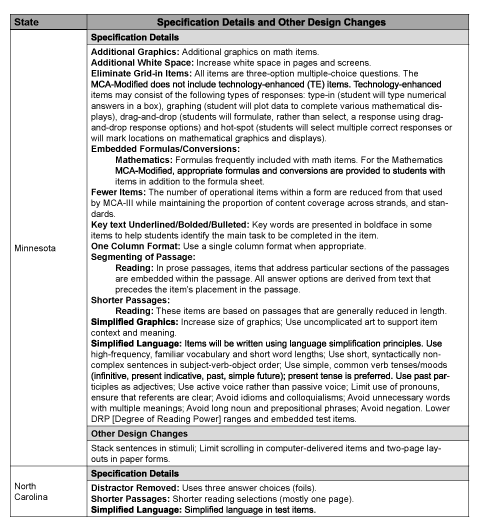
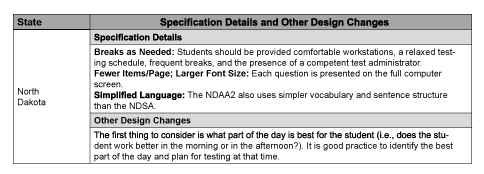
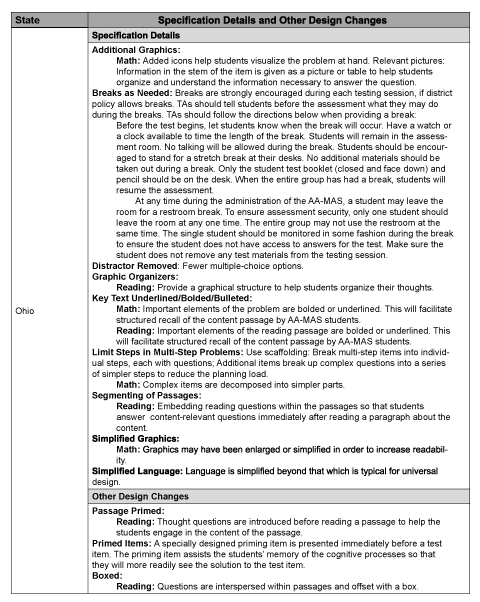
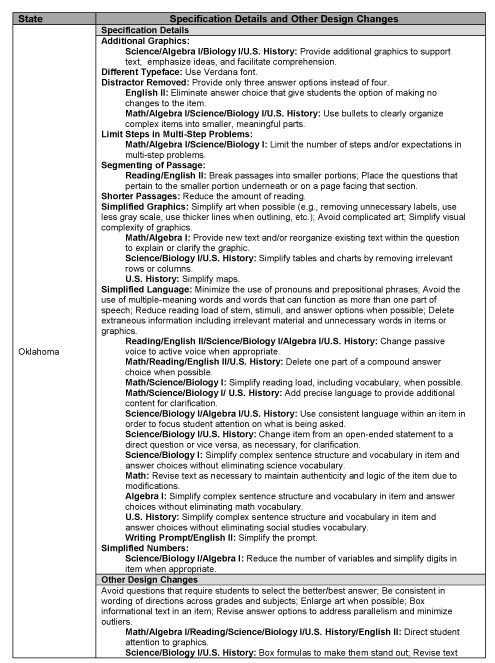
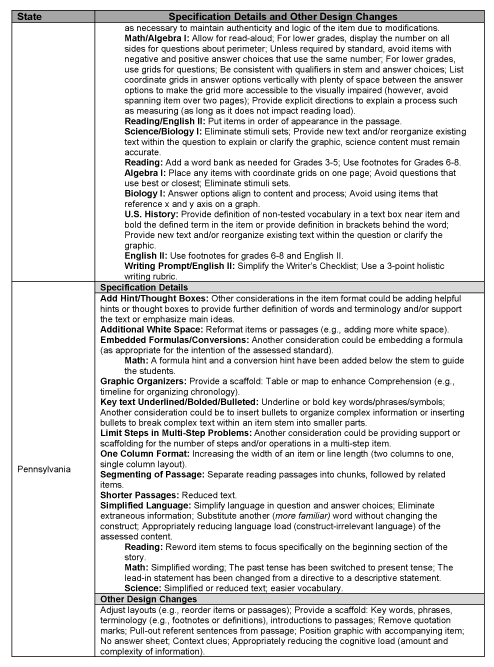
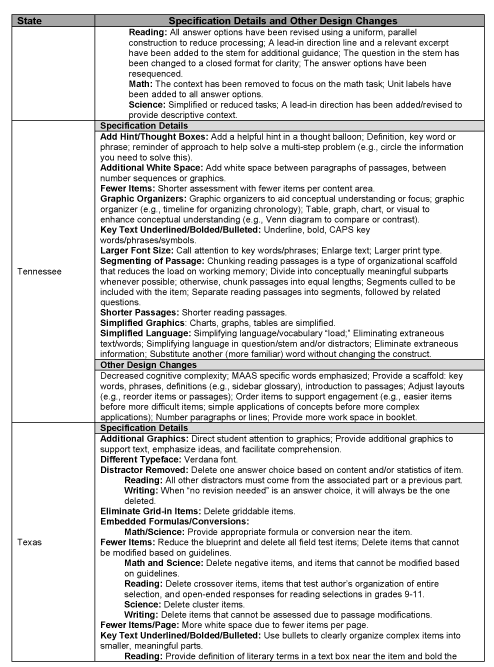
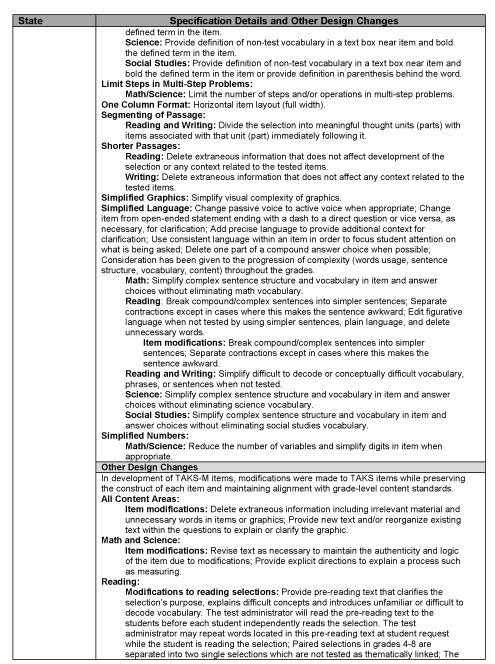
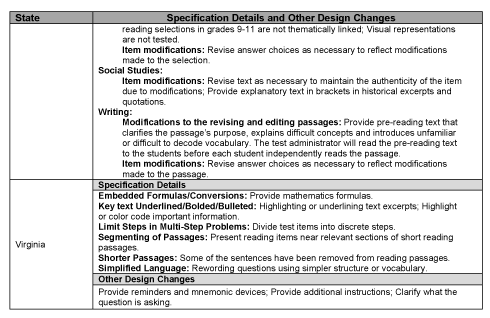
Table B5. Online or
Computer-Based Testing for States'
AA-MAS, 2011
|
State
|
Reading
|
Writing
|
Math
|
Science
|
Social
Studies
|
|
California
|
|
|
|
|
|
|
Connecticut*
|
X
|
|
X
|
|
|
|
Georgia
|
|
|
|
|
|
|
Indiana
|
|
|
|
|
|
|
Kansas*
|
X
|
X
|
X
|
X
|
X
|
|
Louisiana
|
|
|
|
|
|
|
Maryland*
|
X
|
|
X
|
X
|
X
|
|
Michigan
|
|
|
|
|
|
|
Minnesota*
|
|
|
X
|
|
|
|
North Carolina
|
|
|
|
|
|
|
North Dakota*
|
X
|
|
X
|
X
|
|
|
Ohio
|
|
|
|
|
|
|
Oklahoma
|
|
|
|
|
|
|
Pennsylvania
|
|
|
|
|
|
|
Tennessee
|
|
|
|
|
|
|
Texas
|
|
|
|
|
|
|
Virginia*
|
X
|
|
X
|
|
|
|
Total
|
5
|
1
|
6
|
3
|
2
|
* See Table B6 and
Table B7 for descriptions.
Shading indicates a
state does not have a separate
assessment for that content area.
Table B6. Description of
States' Online or Computer-based Testing
for AA-MAS, 2011
|
State
|
Description
|
|
Connecticut
|
General
Description
|
|
Reading:
Beginning with the 2010 test
administration, the Reading
CMT/CAPT MAS tests will be
administered online to all
eligible students. For Reading
CMT MAS, these subtests include
Reading Comprehension and
Degrees of Reading Power (DRP).
For Reading CAPT MAS, these
subtests include Reading for
Information and Response to
Literature. Students registered
on the CAPT/CMT Accommodations
Data Collection Web Site for the
Reading CMT/CAPT MAS tests, take
these tests using the
Measurement Incorporated Secured
Testing (MIST) application; The
2011 MAS administration will
require all students assessed
with the CAPT MAS reading test
to submit their responses using
the MIST application; Students
assessed with the CMT MAS must
be tested in a separate setting
from students assessed with the
standard CMT. Within a school,
each test session of the CMT MAS
must be administered on the same
schedule to students in the same
grade. For example, all Grade 3
students assessed with the CMT
MAS in mathematics must take CMT
MAS Mathematics Session 1 on the
same schedule. There is no
requirement that CMT MAS test
sessions be administered on the
same schedule as the standard
CMT for mathematics and reading.
|
|
Accommodations1
|
|
Reading: The
MIST application is the same
online application used for
students who receive the Word
Processor/Online Computer
Response Accommodation.
Since this will be the primary
method for taking this test,
there is no need to indicate
this is an accommodation on the
accommodation form for the
Reading CMT/CAPT MAS tests; As a
new feature on MIST, students
taking the Reading CMT/CAPT MAS,
who need the
Reader-directions only
accommodation, may have this
accommodation provided through
MIST; MIST will eventually
include features that provide
other accommodations through
this online environment (i.e.,
print/screen enlargement, text
reader for test items, and the
ability to use a variety of
input devices for greater
student response independence);
There are new features on the
MIST application. One of these
features is the Reader of
Directions Only and
Reader of Test Items
accommodation. These
accommodations must be provided
using the text reader available
on the MIST application for all
test sessions except the
supplemental tests.
|
|
Kansas
|
General
Description
|
|
The KAMM is
available through Kansas
Computerized Assessment (KCA).
The Kansas Assessment programs
(computerized and paper and
pencil) are designed to meet the
requirements of the federal No
Child Left Behind Act. The KCA
project provides not only the
online testing interface for
students, but online training
tools, tutorials, and practice
and formative tests for each
subject area to educate and
prepare school personnel and
students for online testing.
|
|
Accommodations1
|
|
Reading, Math,
Science: Paper-pencil
assessments may only be used for
an accommodation; There are
three options for administering
the read-aloud accommodation to
an individual: KCA
administration, KCA audio voice;
KCA administration, adult
reader; Paper/pencil
accommodation, adult reader.
|
|
Maryland
|
General
Description
|
|
Algebra,
Biology, English, and
Government: The Mod-HSA will
be administered either by
computer ("Online" testing) or
by paper and pencil ("Paper"
testing); Online tests are
administered according to a
flexible administration schedule
set by each LEA within the
overall State-mandated HSA
testing window; Online or paper
test-takers without an extended
time accommodation must complete
all three sessions of each
content area test over the
course of a single school day.
|
|
Minnesota
|
General
Description
|
|
Reading
MCA-Modified and the grade 11
Mathematics MCA-Modified are
paper administration mode only.
Grades 5–8 Mathematics
MCA-Modified are online
administration mode only; The
grade 5–8 and 10 Reading
MCA-Modified and grade 11
Mathematics MCA-Modified are
paper administration mode
assessments aligned with the
2003 Academic Content Standards.
These assessments are divided
into four segments. The grades
5–8 Mathematics MCA-Modified are
aligned to the 2007 Academic
Content Standards and are only
administered online. Like the
Mathematics MCA-III, students
taking the test in online
administration mode will be able
to pause at an item and resume
the test at a later time, will
have access to an online
calculator when allowed and will
use an easily accessible formula
sheet; The online Mathematics
MCA and MCA-Modified can be
stopped and resumed by a student
at any point during the test.
Tests are broken into multiple
sections that contain
approximately ten questions
each. When a student completes
the section, they are asked to
confirm they are done. Once they
move beyond the section, they
are not allowed to go back; The
design of the Mathematics MCA
and MCA-Modified allows students
in the same physical setting to
take either test and provides
seamless administration for the
student and teacher—regardless
of which test the student is
taking. Therefore, both the
Mathematics MCA and MCA-Modified
can be administered in the same
lab at the same time; Scheduling
for the online Mathematics MCA
and MCA-Modified may be arranged
around computer availability,
allowing an entire class of
students to pause their
administration at different
points in the assessment and
returning to complete it at a
later time.
|
|
Accommodations1
|
|
Use of an
Accommodated Form with Online
Grades 5–8 Mathematics
MCA-Modified Accommodations:
Students must be assigned an
accommodated form of the
Mathematics MCA-Modified online
test during session set-up when
using the accommodated audio or
script accommodation in
conjunction with the online
test. The accommodated audio is
embedded in the accommodated
form. If students are using a
script accommodation in
conjunction with the online
form, make sure volume is muted
before logging into TestNav and
headphones are not being used by
students. The Test Monitor must
read exactly what is stated in
the script. Refer to the
Instructions for Use of Script
Accommodations for more
information on the script
accommodation. Students must
also be assigned an accommodated
form if they will be using a
large print or Braille test book
because a scribe will enter the
student's answers from the large
print or Braille test book into
an online accommodated test on
PearsonAccess. A
read-aloud of items is provided
via built-in audio in the online
assessment.
|
|
North
Dakota
|
General
Description
|
|
Language Arts,
Mathematics, Reading, and
Science: The NDAA2 is a test
which is given on a computer via
a secure online web-based
system. The NDAA2 consists of
four sub-tests which can be
taken in any order during the
NDAA2 assessment window; The
NDAA2 needs to be taken on a
computer in a quiet, secure area
free of distractions, with
direct supervision; Each
question is presented on the
full computer screen; Answer
choices are presented at the
bottom of the screen and require
that the student select one of
the choices using the computer
mouse; The next page/question is
reached by using the mouse to
toggle forward using the arrow
at the bottom of the page; The
student is able to go back and
forth using the mouse to review
answers and make changes if
desired; Each sub-test is
submitted by clicking on
"submit" at the end of the test;
Each answer is recorded as the
student answers it.
|
|
Accommodations1
|
|
Language Arts,
Mathematics, Reading, and
Science: If the student is
unable to use the mouse or make
the answer choices alone, the
teacher must assist by selecting
the choices that the student
makes. This should be recorded
as an accommodation of using a
scribe. As a scribe, the teacher
may not help the student answer
the questions or give any hints.
A scribe can only provide
answers given by the student.
|
|
Virginia
|
General
Description
|
|
The VMAST will
provide eligible students with
access to online assessments in
reading and mathematics that
include research-based supports
and simplifications identified
by Virginia educators.
|
|
Accommodations1
|
|
If a student's
Individualized Education Plan
(IEP) includes accommodations,
those accommodations should be
provided during the VMAST
practice test, if possible. If a
student's accommodation includes
an audio assessment, the
practice test should be read
aloud to the student. Audio
copies of these assessments are
not available at this time.
|
1For
additional information about AA-MAS
accommodations policies see Lazarus,
Cormier, Crone, & Thurlow (2010).
Table B7. Online or
Computer-Based Testing: Availability of
Online Tutorials and Practice Tests for
States' AA-MAS, 2011
|
State
|
Tutorials
Available
|
Practice Tests
Available
|
General
Description and Specifications
|
|
Connecticut
|
|
X
|
General
Description
|
|
Connecticut has
CMT MAS and CAPT MAS practices
tests available for both
mathematics and reading. For the
CMT MAS, the practice tests for
math are not grade specific. The
reading practice tests include
grades 3-5 and grades 6-8. The
CAPT MAS practice tests for
science, reading, and math are
not grade specific.
|
|
Specifications
|
|
Students
assessed with the CMT MAS will
take the same practice test with
students assessed with the
standard CMT. An optional CMT
MAS Practice Test is available
on the CSDE Website. The CMT
MIST Practice Site is available
for students to become familiar
with the MIST application; This
site allows students to take an
online test using the
Measurement Incorporated Secure
Test (MIST) system. These
practice tests are available to
provide students with a
first-hand look at the online
testing interface before the
live test administration in
March. Students will also have
the opportunity to practice
using the available online tools
as well as learn how to navigate
through the test. No feedback or
results will be provided.
|
|
Web site Link
|
|
https://mist.measinc.com/Proctor/Practice
|
|
Kansas
|
X
|
X
|
General
Description
|
|
Kansas has
online tutorials and practice
test items for each content area
and grade level. The tutorials
and practice tests are available
online but can be downloaded via
software onto individual
computers for practice and
testing. Tutorials are available
for students and teachers.
|
|
Specifications
|
|
KCA offers
student tutorials that explain
to the students how the KCA
software works. Audio and
non-audio tutorials are
available. It is recommended
that teachers review these
tutorials as well. It may also
be useful as a means of sharing
information about the KCA system
with others (e.g., other
educators, parents, board
members, site councils, etc.);
The practice tests and tutorials
can be accessed by downloading
the KCA software on any computer
that will be used to take the
KCA practice, Formative,
Interim, or Real NCLB test. Once
you download the KCA software,
you can access the tutorials
from the button in the bottom
right of the KCA menu page. The
KCA Practice Tests can be
accessed by clicking on the
Practice Using the KCA Software
link.
|
|
Web site Link
|
|
http://www.cete.us/kap/downloads/
|
|
Maryland
|
X
|
X
|
General
Description
|
|
Maryland has
online tutorials and practice
items for each content area and
grade level of the Mod-HSA and
Mod-MSA.
|
|
Specifications
|
|
The resources
here are intended to support and
enhance student preparation for
the Maryland State Assessments.
These tutorials provide direct
exposure to the format and
structure of the questions, and
enable users to receive direct
feedback for each item. This
site provides access to all
Maryland assessments that are
online including the Mod-HSA and
the Mod-MSA for each content
area.
|
|
Web site Link
|
|
http://www.pearsonaccess.com/cs/Satellite?c=Page&childpagename=Maryland%2FmdPALPLayout&cid=1175826727300&pagename=mdPALPWrapper
|
|
Minnesota
|
X
|
X
|
General
Description
|
|
Minnesota has
online tutorials and item
samplers available for the
mathematics MCA-modified for
grades 5-8.
|
|
Specifications
|
|
The purpose of
the item samplers is to
familiarize students with the
online MCA-Modified test format.
The item samplers may also be
used as venues for future item
releases.
|
|
Web site Link
|
|
http://www.pearsonaccess.com/cs/Satellite?c=Page&childpagename=Minnesota%2FmnPALPLayout&cid=1205461255328&p=1205461255328&pagename=mnPALPWrapper&
resourcecategory=Student+Tutorialsan>
|
|
North
Dakota
|
X
|
|
General
Description
|
|
A tutorial
through the online program is
available for teachers.
|
|
Specifications
|
|
Getting online –
Directions for Teachers; To take
the sample 2% test, click on the
"Sample 2% Test" to get a feel
for how the test will work. This
sample test will take you
through a three-item test.
|
|
Web site Link
|
|
http://www.datadrivenenterprises.com/ndaa/
|
|
Virginia
|
|
X
|
General
Description
|
|
Virginia has
practice tests available for
Math grades 3-8 and Algebra I.
Software for the practice tests
must be downloaded onto a
computer for access. Guides for
teachers to use to familiarize
students with the supports and
simplification are available.
|
|
Specifications
|
|
The VMAST
practice items give students the
opportunity to use
research-based supports and
simplifications that have been
applied to existing online
mathematics items to make them
more accessible for students
with disabilities. The practice
items are samples only. They do
not cover all mathematics
content for the grade level or
course, nor do they provide
examples of all item types or
functionality that may be found
in the field test items.
|
|
Web site Link
|
|
http://www.doe.virginia.gov/testing/online_testing/index.shtml
|
|
Total
|
4
|
5
|
|
Table B8. States'
Considerations for ELL Students with
Disabilities on AA-MAS, 2011
|
State
|
Considerations
|
|
California
|
Description
|
|
The CMA consists
of untimed tests, but almost all
students should complete the
tests within the times listed.
Each test part must be
administered in a single sitting
with no breaks unless the
student has an IEP or Section
504 plan that allows for breaks
as a testing accommodation or
the student is an English
learner who is eligible for
breaks as a testing variation.
However, if some students are
actively working on a test when
time is called, they must be
allowed time to complete it.
|
|
Accommodations 1
|
|
Allowable
English Learner (EL) Variations
Hear the test
directions printed in the test
administration manual translated
into the student's primary
language. Ask clarifying
questions about the test
directions in the student's
primary language. Additional
supervised breaks within a
testing day or within a test
part provided that the test part
is completed within the day of
testing. The end of a test part
is identified by a "STOP" sign;
English learners (ELs) may have
the opportunity to be tested
separately with other ELs
provided that the student is
directly supervised by an
employee of the school who has
signed the test security
affidavit and the student has
been provided such a flexible
setting as part of his/her
regular instruction or
assessment.
CMA for Math and
Science ONLY
Access to
translation glossaries/word
lists (English-to-primary
language). Glossaries/word lists
shall not include definitions or
formulas.
|
|
Connecticut
|
Description
|
|
A special
education student who is also an
English Language Learner (ELL)
assessed with the CMT/CAPT MAS
would follow the same criteria
for exiting ELL services as all
ELL students. More information
can be accessed on the CSDE's
Web site:
http://www.csde.state.ct.us/public/cedar/assessment/common/MAS2010memo.pdf
|
|
Georgia
|
|
|
Indiana
|
|
|
Kansas
|
|
|
Louisiana
|
Description
|
|
A student may be
classified as both LEP and
special education and be
eligible to participate in LAA
2.
|
|
Accommodations 1
|
|
Use of the
following LEP accommodations
will be determined by the
classroom teacher or other
individual providing language
services: extended time,
individual/small group
administration, provision of
English/native language
word-to-word dictionary (no
definitions), test administered
by ESL teacher or by individual
providing language services,
tests read aloud. LEP students
who are eligible for LAA 2 may
qualify for LEP accommodations
provided they are routinely used
in the students' classroom
instruction and assessment and
do not breach test security or
invalidate the meaning of the
test score or the purpose of the
test. Answer documents for LEP
students who have been enrolled
in a primarily English-speaking
school for less than a year may
be coded for accountability. Do
not translate passages,
introductions, items/questions,
or answer options on the test
from English. General directions
to the test, which appear in the
manual, may be translated, as
well as the boxed directions in
the test booklet that appear at
the beginning of the Reading and
Responding and Proofreading
sessions of the English Language
Arts test. Students must respond
in English; student responses
may not be translated.
|
|
Maryland
|
Description
|
|
There are
special rules that apply to the
participation of English
Language Learners (ELLs) in the
MSA-Reading and the
Mod-MSA-Reading, as follows: ELL
students in their first year of
enrollment in a U.S. school may
substitute their score on the
English Language Proficiency
Test for the MSA-Reading or the
Mod-MSA-Reading test. ELL
students must participate in the
MSA-Reading or the
Mod-MSA-Reading test starting in
their second year of enrollment
in a U.S. school; There are
special rules that apply to the
participation of English
language learners (ELLs) in the
MSA-Math and the Mod-MSA-Math,
as follows: For the MSA-Math and
Mod-MSA-Math, ELL students must
participate in MSA-Math or
Mod-MSA-Math regardless of how
recently they entered the U.S.
educational system. For ELL
students in their first year of
enrollment in a U.S. school,
"participation" in the MSA-Math
or the Mod-MSA-Math is defined
as allowing the student to
attempt the test for at least 20
minutes. If, after 20 minutes,
the TE determines in his or her
professional judgment that the
student does not possess
sufficient English fluency to be
able to continue testing, the
test administration for that
student may be concluded at that
time.
|
|
Accommodations 1
|
|
Accommodations
for assessment of students with
disabilities (i.e., students
having an Individualized
Education Program or a Section
504 Plan) and students who are
English language
learners (ELL) had to be
approved and documented
according to the procedures and
requirements outlined in the
document entitled "Maryland
Accommodations Manual: A Guide
to Selecting, Administrating,
and Evaluating the Use of
Accommodations for Instruction
and Assessment" (MAM). A copy of
the most recent edition of this
document is available
electronically on the LAC and
STC web pages at
https://docushare.msde.state.md.us/docushare
|
|
Michigan
|
Description
|
|
Students should
only use accommodations on state
assessments if 1) the
accommodation is documented in
the IEP, Section 504 Plan, or
ELL plan 2) the accommodation is
routinely used as part of the
student's daily instruction, 3)
the student is proficient in
using the accommodation, and 4)
the effectiveness of the
accommodation(s) has been
determined prior to use on an
assessment.
|
|
Accommodations 1
|
|
Standard
Accommodations for ELL students
on MEAP or MEAP-Access2:
Equipment/Materials:
Audio/Video
Equipment: MEAP-Access does
not offer video translated
versions.
Dictionary/Glossary: Use of
bilingual word-for-word
non-electronic translation
glossary for English language
learners.
Visual
organizers: Use of acetate
color shield, highlighters,
highlighter tape, page flag, and
reading guides on test booklets.
Other: Use
of rulers as provided by the
state.
Presentation:
Administration
by Others: Qualified person
familiar to the student
administers the assessment
(e.g., Special Education
teacher, Bilingual/ESL staff).
Native Language
Translation of Directions and/or
Items: Reading all
assessment directions in
student's native language
(student must be dominant in
that native language; and
student's English proficiency is
determined to be basic or lower
intermediate; and student
receives bilingual instruction
in their native language for the
maintenance of that language);
Reading content and questions in
the student's native language
(Mathematics, Social Studies,
Science and Writing; student
must be dominant in a native
language other than English; and
student's English proficiency is
determined to be basic or lower
intermediate; and student
receives bilingual instruction
in that native language for the
maintenance of that language).
Prompt/Encourage
Student: Teacher provides
visual, auditory, or physical
cues to student to begin,
maintain, or finish task.
Read Aloud
Questions: Reading aloud the
Mathematics, Science, and Social
Studies assessments with
individual students or in small
groups of no more than 5
students (MEAP-Access requires
the use of reader scripts).
Read/Re-read/Clarify Directions:
Assessment directions
(teachers may emphasize key
words in directions, teachers
may repeat directions exactly as
worded in administrator manual,
student may restate directions
in his/her words, student may
ask for clarification of
directions).
Sign interpret
directions: Directions
provided using sign language
(American Sign Language (ASL) or
Exact English).
Response:
Pointing:
Student points to answers.
Write in Test
Booklet: Student writes
directly in assessment booklet
(transferred to answer document
by teacher).
Scheduling/Timing:
Extended Time:
Extended assessment time.
Flexible
scheduling: Administer the
parts within a content area in
any order.
Time beneficial
to student: Administration
of the assessment at a time most
beneficial to the student, with
appropriate supervision.
With breaks:
Frequent supervised breaks;
Method of informing students of
remaining time (e.g., clock or
timer).
Setting:
Increase/decrease opportunity
for movement: Able to move,
stand or pace during assessment
in a manner where others' work
cannot be seen and is not
distracting to others (e.g.,
kneeling, constant movement).
Individual:
Administration of the assessment
individually or in a small
group.
Seat
location/proximity:
Placement of student where
he/she is most comfortable
(e.g., front of the room, back
of the room); Placement of
teacher/proctor near student.
Separate
room/Minimize distractions:
Administration of the assessment
in an alternate education
setting (in school) with
appropriate supervision (e.g.,
Bilingual/English as a second
language setting, special
education setting, in a
distraction free space or
alternate location such as
separate room or location within
room).
|
|
Minnesota
|
Accommodations 1
|
|
English learners
must be coded LEP in MARSS in
order to use an accommodation on
the state assessments. Students
with an IEP or 504 Plan are also
eligible to receive
accommodations. Districts must
ensure that all accommodations
received by students are
justified and supported by data
teachers collect during
instruction. ELs may be provided
any appropriate accommodations
from Tables 12 and 13. If an EL
has an IEP or 504 Plan, refer to
the tables of accommodations in
Chapter 5 in addition to the
accommodations in Tables 12 and
13. For ELs, the accommodations
providing linguistic support may
be combined with accommodations
for students with disabilities.
When an eligible EL demonstrates
the need for an accommodation,
it must be provided as long as
it does not invalidate the
assessment.
Explanation of
Accommodations for English
Learners
Word-to-word
dual-language dictionary: A
word-to-word dual-language
dictionary is not allowed for
the Mathematics BST, but is
permitted on the Mathematics
MCA, Mathematics MCA-Modified
and Science MCA.
Extended testing
time (same day)
for the TEAE is
available to ELs with an IEP or
504 Plan. Other EL students must
finish the segment(s) within the
time allowed.
Scripts or
accommodated audio for grades
5–8 Mathematics MCA-Modified,
Science MCA and
Mathematics GRAD retest may
be provided to ELs who need
them. Full accommodated audio is
incorporated into the
accommodated form of each test.
A student who needs the script
or accommodated audio in
conjunction with the online
assessment must be assigned an
accommodated form during test
session set-up in PearsonAccess.
The accommodated
audio differs from the regular
audio because it not only reads
all of the questions and answer
choices, but also reads all of
the labels, graphs and charts.
The accommodated audio may be a
heavy language load that may not
be beneficial for all English
Learners. Only a small number of
students typically need the
accommodated audio or script;
the default should be the
regular audio. Script for
Mathematics MCA or grade 11
MCA-Modified (on CD or read to
student) may be provided to
English learners. Mathematics
scripts (MS) and CDs (MC) are
keyed to a corresponding test
book.
Tape recording a
reading test may be done in
individual testing settings. The
student may read the reading
test into a tape recorder. The
student may replay the tape as
the test is taken. Recording
should be done independently by
the student without the Test
Monitor providing verbal or
non-verbal prompts.
Translated
directions and writing prompts
(oral, written or ASL) in
first language. For TEAE, ASL is
allowed only for writing
prompts.
Voice feedback
devices or whisper phones
allow students to vocalize as
they read and work problems. The
use of whisper phones must not
be audible to other students.
|
|
North Carolinant>
|
Description
|
|
To determine
student participation in the
NCEXTEND2 EOG for reading
comprehension, mathematics,
and/or science the following
eligibility requirements must be
considered: the student, if
identified as limited English
Proficient (LEP), must also have
a current IEP.
|
|
North Dakota
|
|
|
Ohio
|
|
|
Oklahoma
|
|
|
Pennsylvania
|
Description
|
|
Are ELLs
required to take the PSSA or
PSSA-M?
In 2004, the
USDE released guidance on
participation of LEP students
(ELLs) in state assessments.
This flexibility allows ELL
students in their first year of
enrollment in U.S. schools an
option of taking the Reading
PSSA. A student's enrollment in
a school in Puerto Rico is not
to be considered as enrollment
in a U.S. school; Those ELLs who
fall into the first category
(ELL and enrolled in a U.S.
school after May 7, 2010), are
considered to be in their first
year in a U.S. school and are
not required to take the PSSA
Reading (grades 3-8 and 11) or
PSSA Writing (grades 5, 8, and
11) tests; All ELLs are required
to participate in the
Mathematics PSSA (grades 3-8 and
11) or PSSA-M (Grades 4-8 and
11) and the Science PSSA (grades
4, 8, and 11), with
accommodations as appropriate
(see below).
|
|
Accommodations 1
|
|
What
accommodations are allowable for
ELLs?
Three separate
accommodations are allowed:
1. Word-to word
translation dictionaries,
without definitions and without
pictures (for Mathematics PSSA,
PSSA-M, Keystone Algebra and the
Science PSSA, PSSA-M, or
Keystone Biology only; not for
any part of the Reading PSSA &
PSSA-M, Keystone Literature test
or on any part of the Writing
PSSA and Keystone English
Composition tests). 2. Qualified
interpreters/sight translators
(for Mathematics PSSA, PSSA-M,
Keystone Algebra and Science
PSSA, PSSA-M, Keystone Biology
only; not for any part of the
Reading PSSA test, Keystone
Literature Exam or on any part
of the Writing PSSA, Keystone
English Composition (except for
the essay prompts on the PSSA
Writing, Keystone English
Composition tests). 3.
Spanish/English Mathematics,
Science, Algebra, and Biology
tests
Is a Spanish
Version of the PSSA available
for Mathematics for Grades 3-8
and 11, for Mathematics PSSA-M,
for Grades 4-8 and 11, for
Science for Grades 4, 8, and 11,
for Algebra and Biology Keystone
paper/pencil exams?
Yes. A Spanish
version of each Mathematics
PSSA, PSSA-M, Science PSSA,
Science PSSA-M, Algebra, and
Biology Keystone paper/pencil
exams is available for students
who have been enrolled in
schools in the United States for
fewer than three years. The
local educational agency may
make a determination to assess
students with this accommodation
when the student is enrolled in
U.S. schools for fewer than
three years and has not yet
reached a level of English
language proficiency sufficient
to yield valid and reliable
information when assessed in
English; It is recommended that
Spanish language students be
literate in their native
language for this accommodation
to be beneficial. However, the
Spanish-language version of the
assessment may be read aloud to
an eligible ELL student who can
benefit from receiving the
assessment in Spanish (for
example, an ELL with prior
education in Spanish who is also
dyslexic).
|
|
Tennessee
|
|
|
Texas
|
Description
|
|
Linguistically
accommodated testing (LAT)
administrations are required for
immigrant English language
learners (ELLs), including those
served by special education, who
meet participation criteria for
mathematics, science, and
reading/ELA tests in grades 3-8
and 10. The LAT process enables
eligible immigrant ELLs to be
assessed with linguistic
accommodations that help them
better understand the language
used on the tests. When taking a
LAT administration of TAKS-M,
eligible students are able to
receive accommodations that
address both their special
education needs and needs as
immigrant ELLs. With the
exception of the grade 10 TAKS-M
ELA test, the regular TAKS-M
booklets are used for LAT
administrations of TAKS-M.
Students who need a large-print
version of the LAT TAKS-M test
will use the large-print TAKS-M
test.
|
|
Accommodations 1
|
|
LAT Mathematics
and Science Accommodations:
Allowable
Accommodations Providing
Indirect Linguistic Support:
Clarification of test
directions; Breaks at request of
student.
Allowable
Accommodations Providing Direct
Linguistic Support:
Linguistic
simplification;
Oral translation; Reading
(decoding) assistance; Bilingual
dictionary;
Bilingual
glossary; English and Spanish
tests side by side (grades 3-5).
LAT Reading
Accommodations:
Allowable
Accommodations Providing
Indirect Linguistic Support:
Clarification of test
directions; Breaks at request of
student; Testing over two days.3
Allowable
Accommodations Providing Direct
Linguistic Support:
Bilingual dictionary;
English
dictionary; Reading aloud—word
or phrase; Reading aloud—entire
test item; Oral
Translation—word
or phrase; Clarification—word or
phrase.
|
|
Virginia
|
|
1For
additional information about AA-MAS
accommodations policies see Lazarus,
Cormier, Crone, & Thurlow (2010).
2
Categories and definitions for
accommodations were added, based on
Lazarus et al. (2010).
3 A two-day
LAT administration of a TAKS-M
reading/ELA test is optional. The LPAC
and ARD committee decide in advance
whether the student should complete the
test in one or two days.
|























